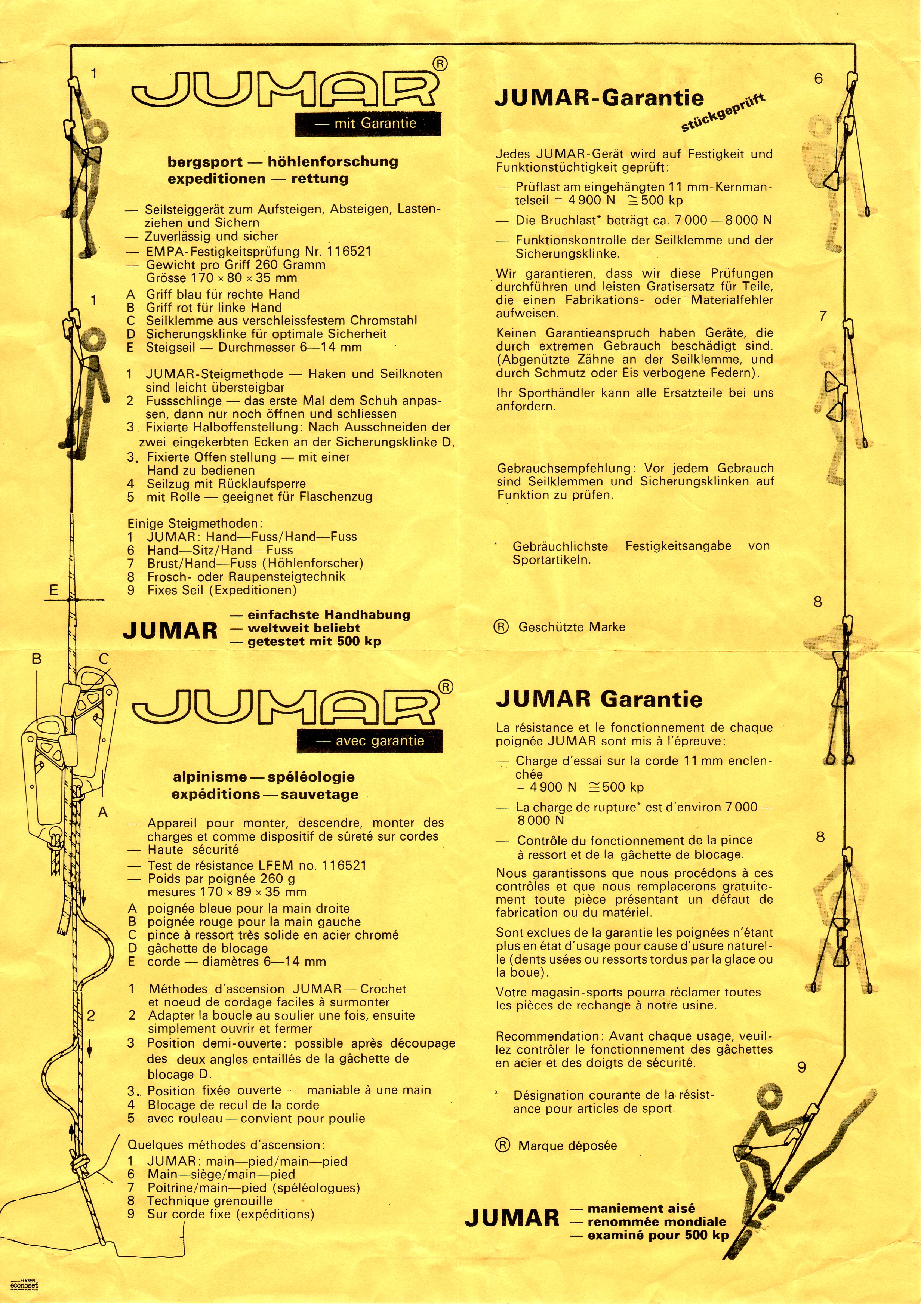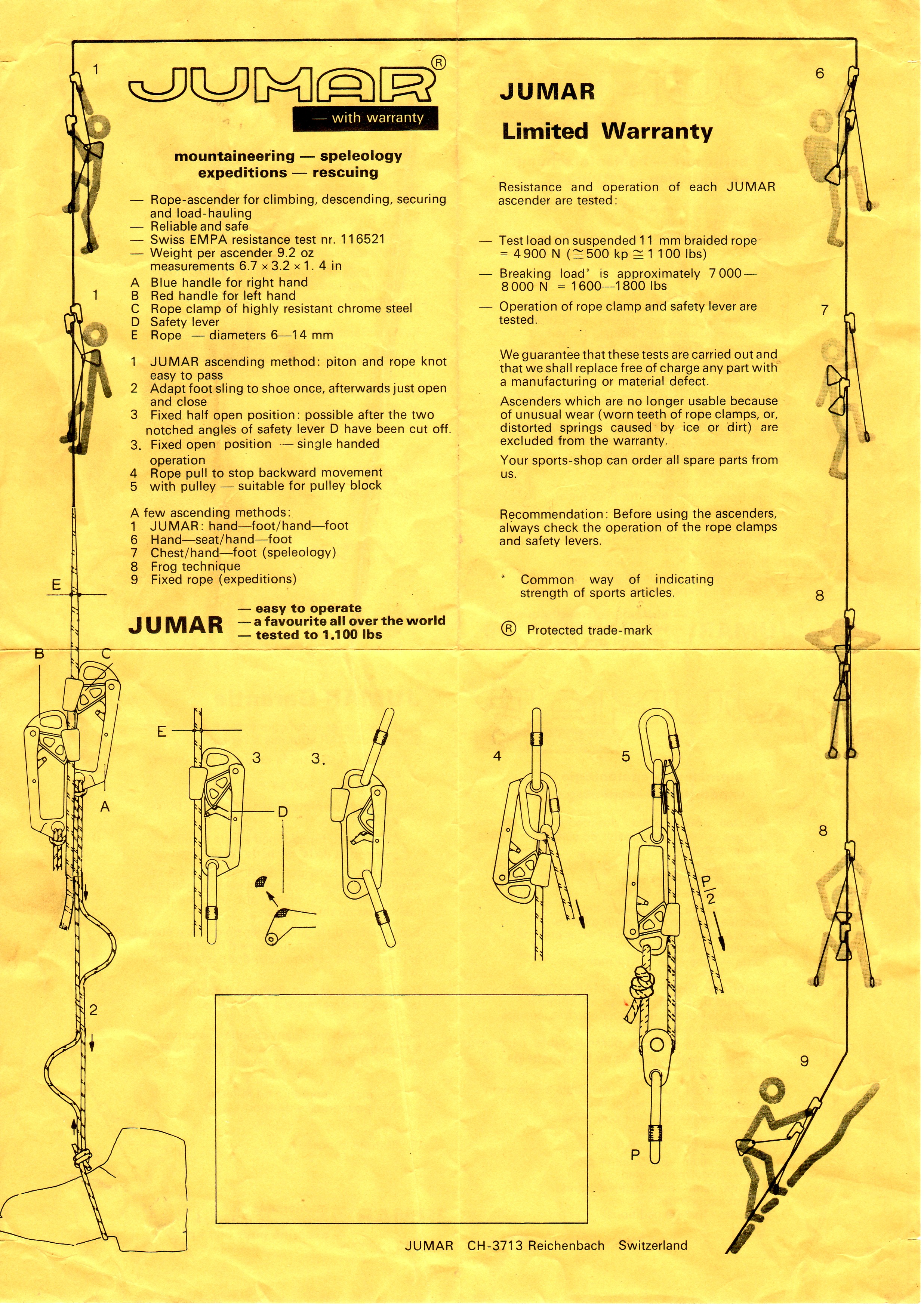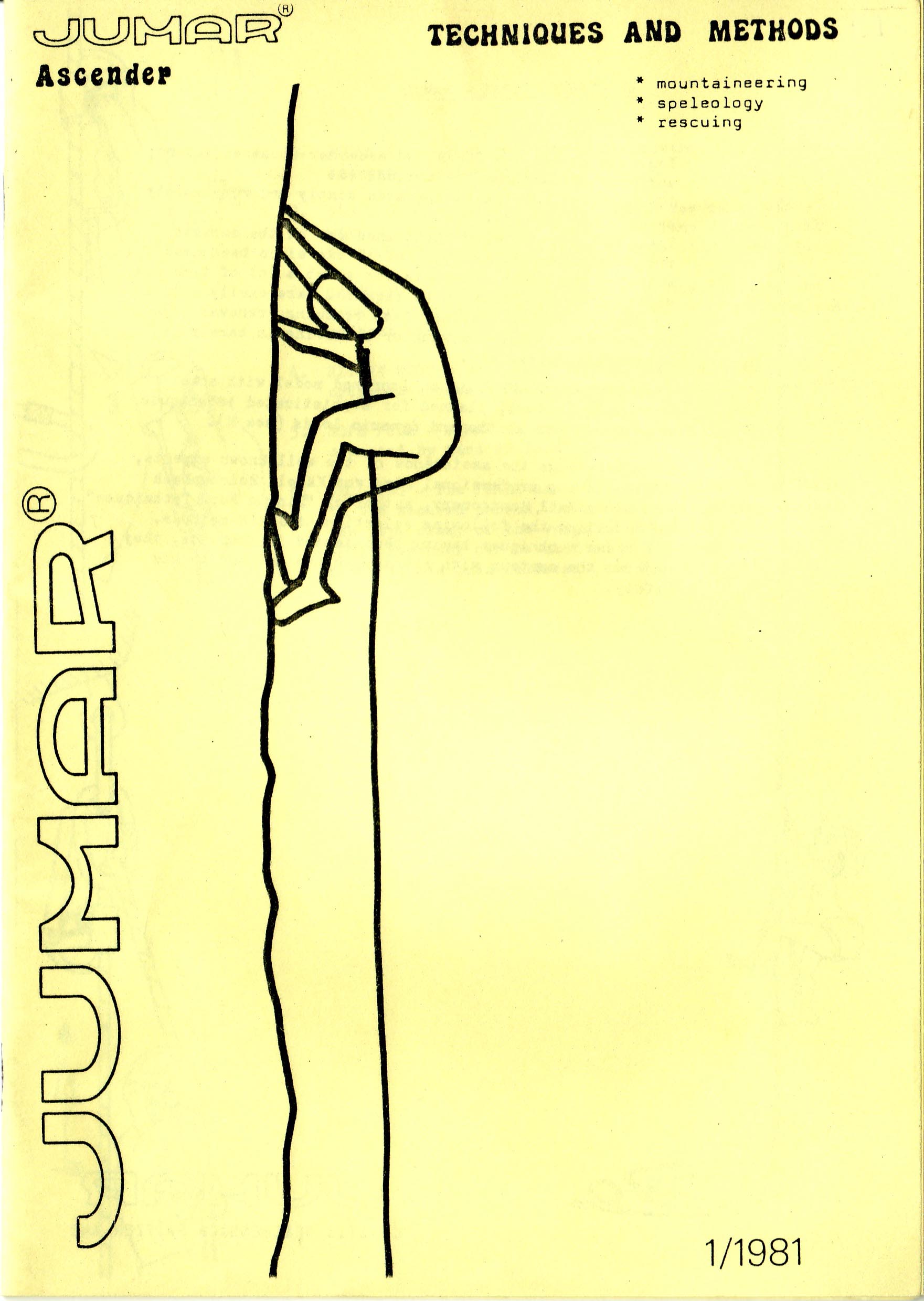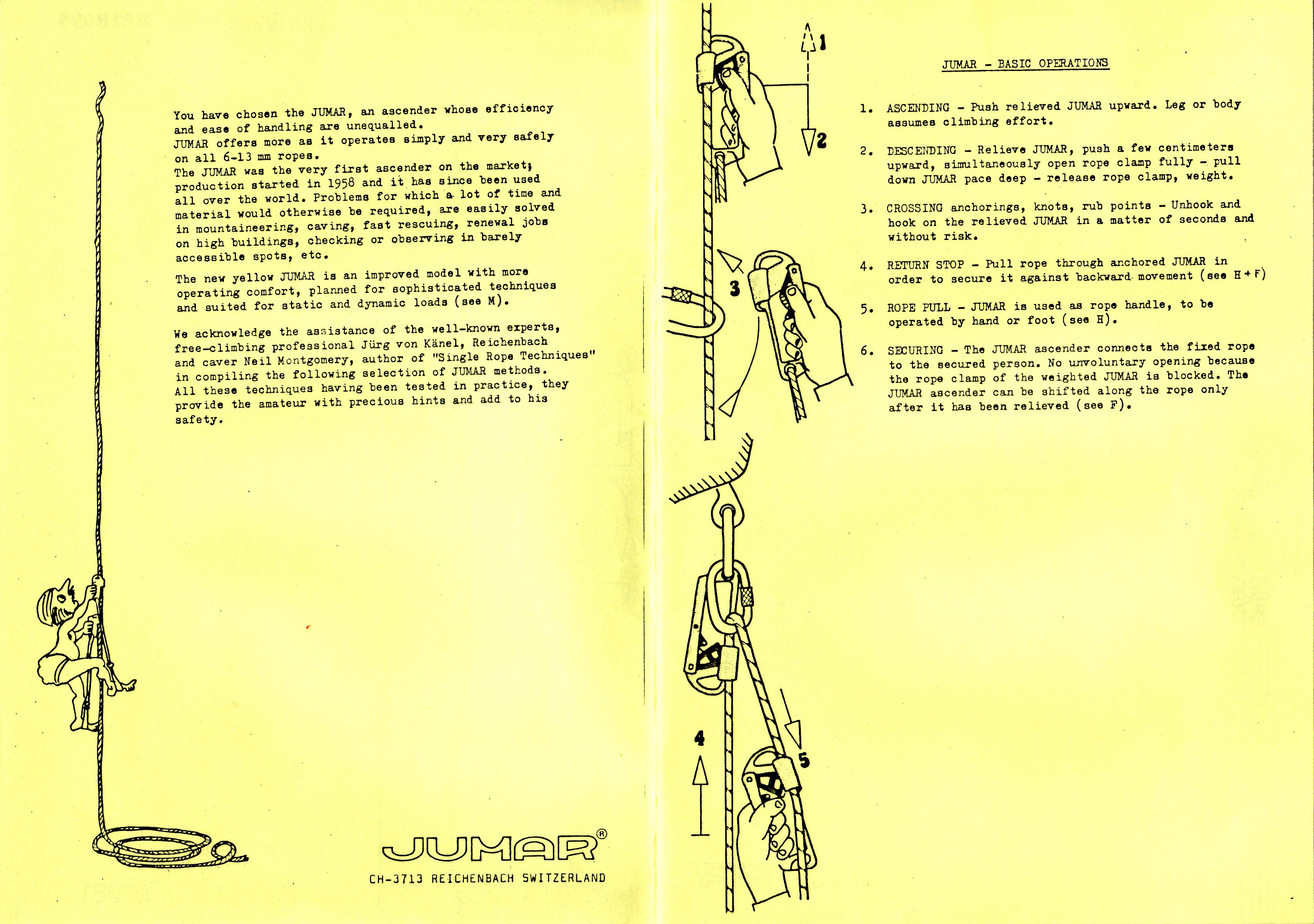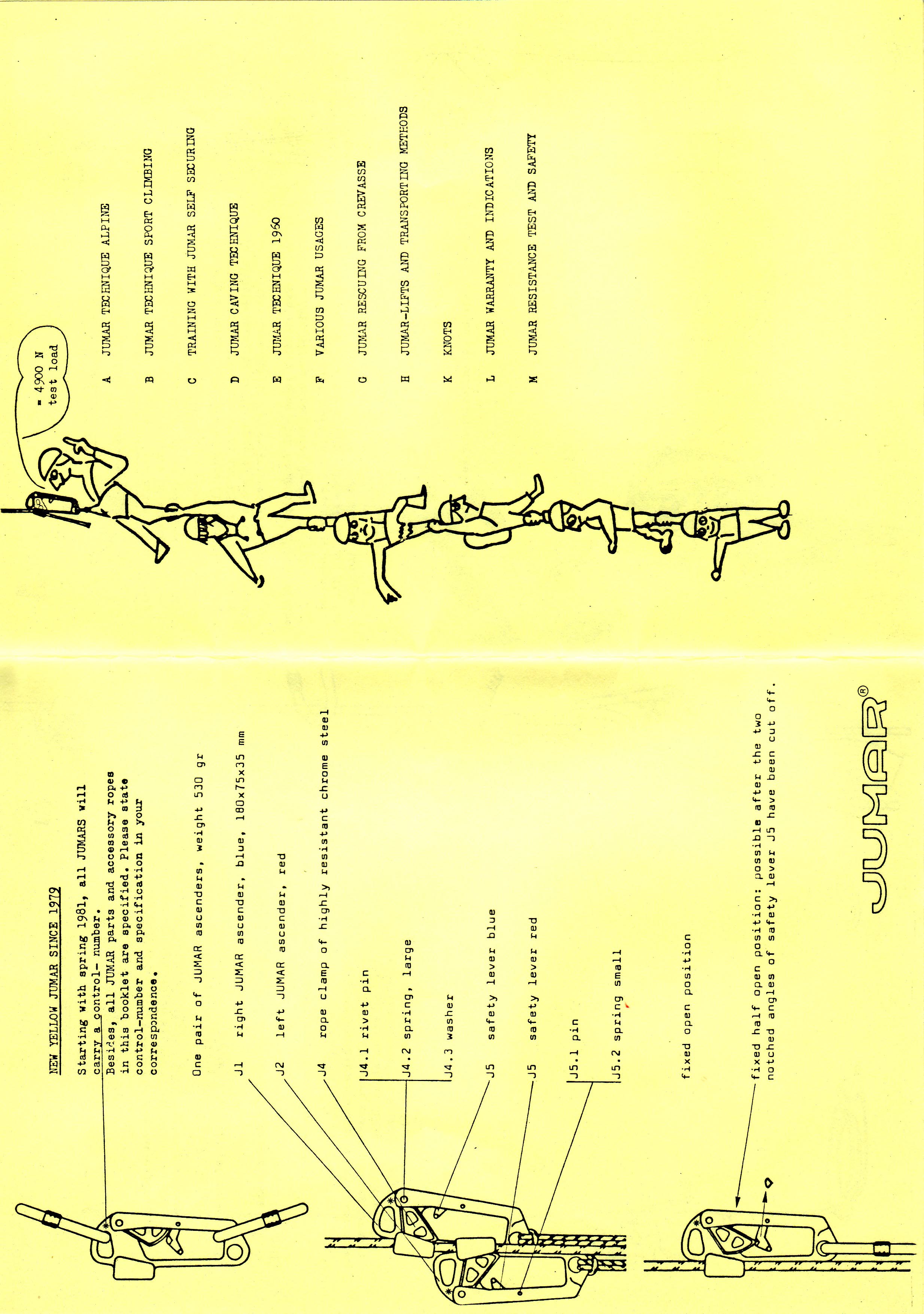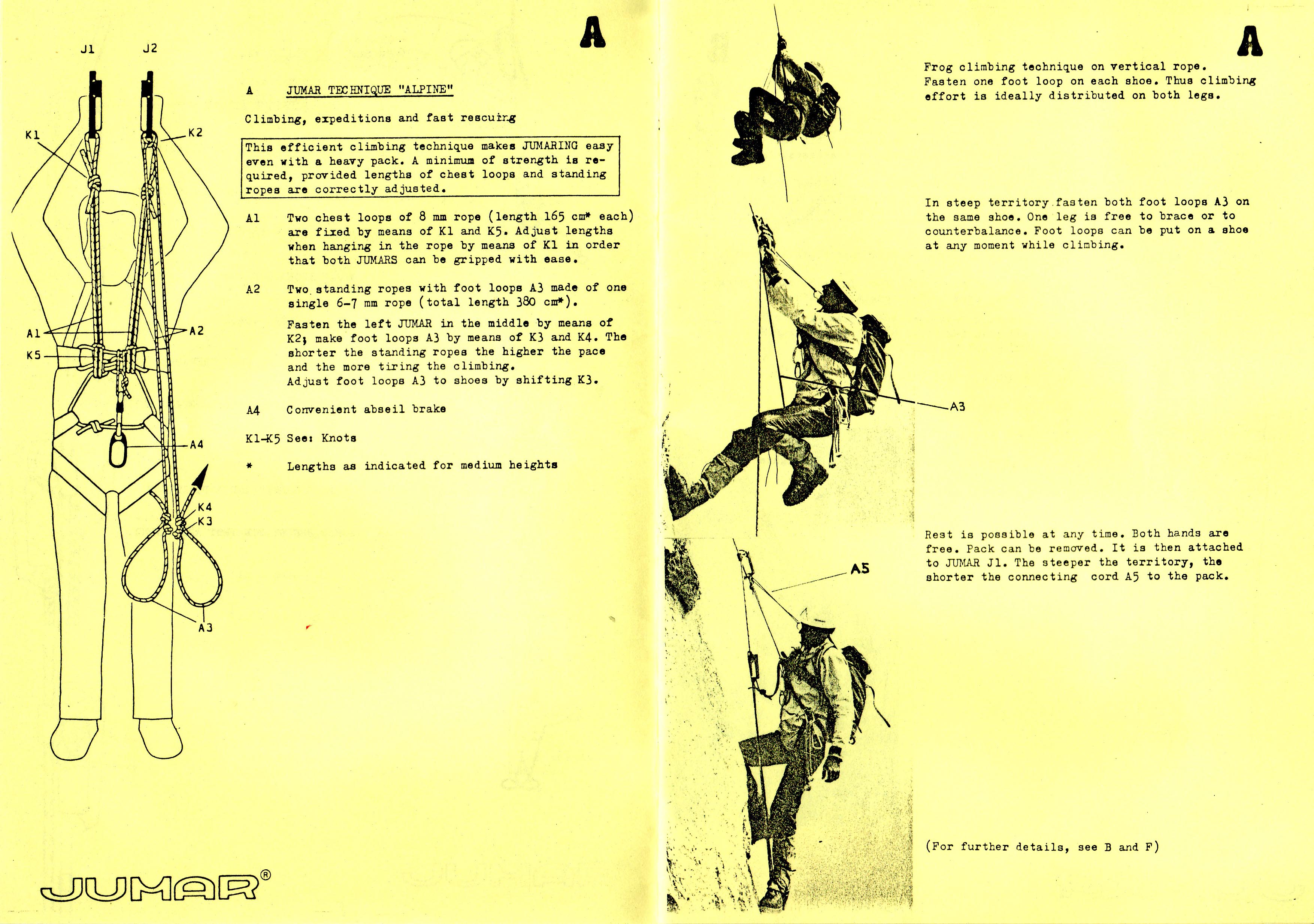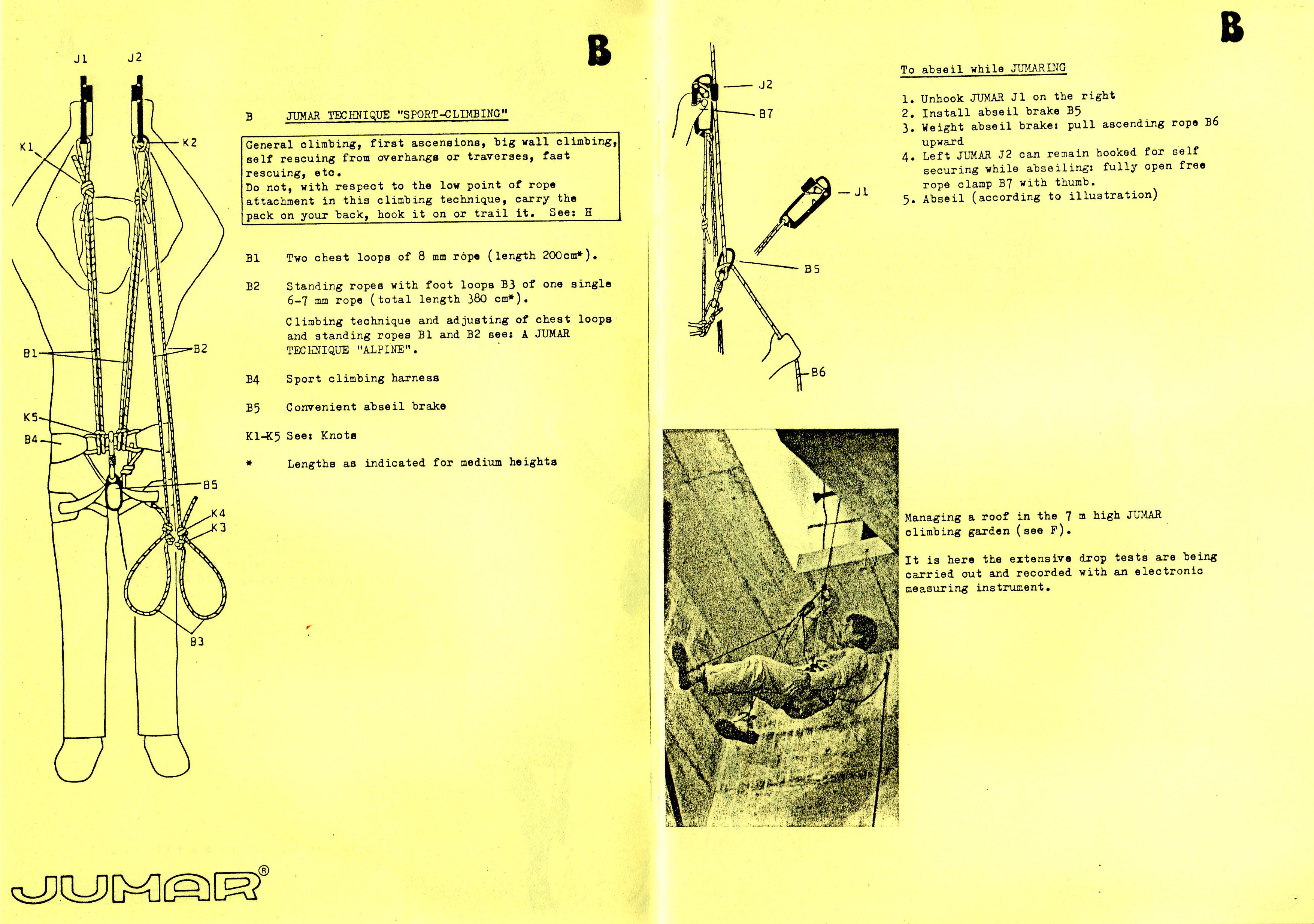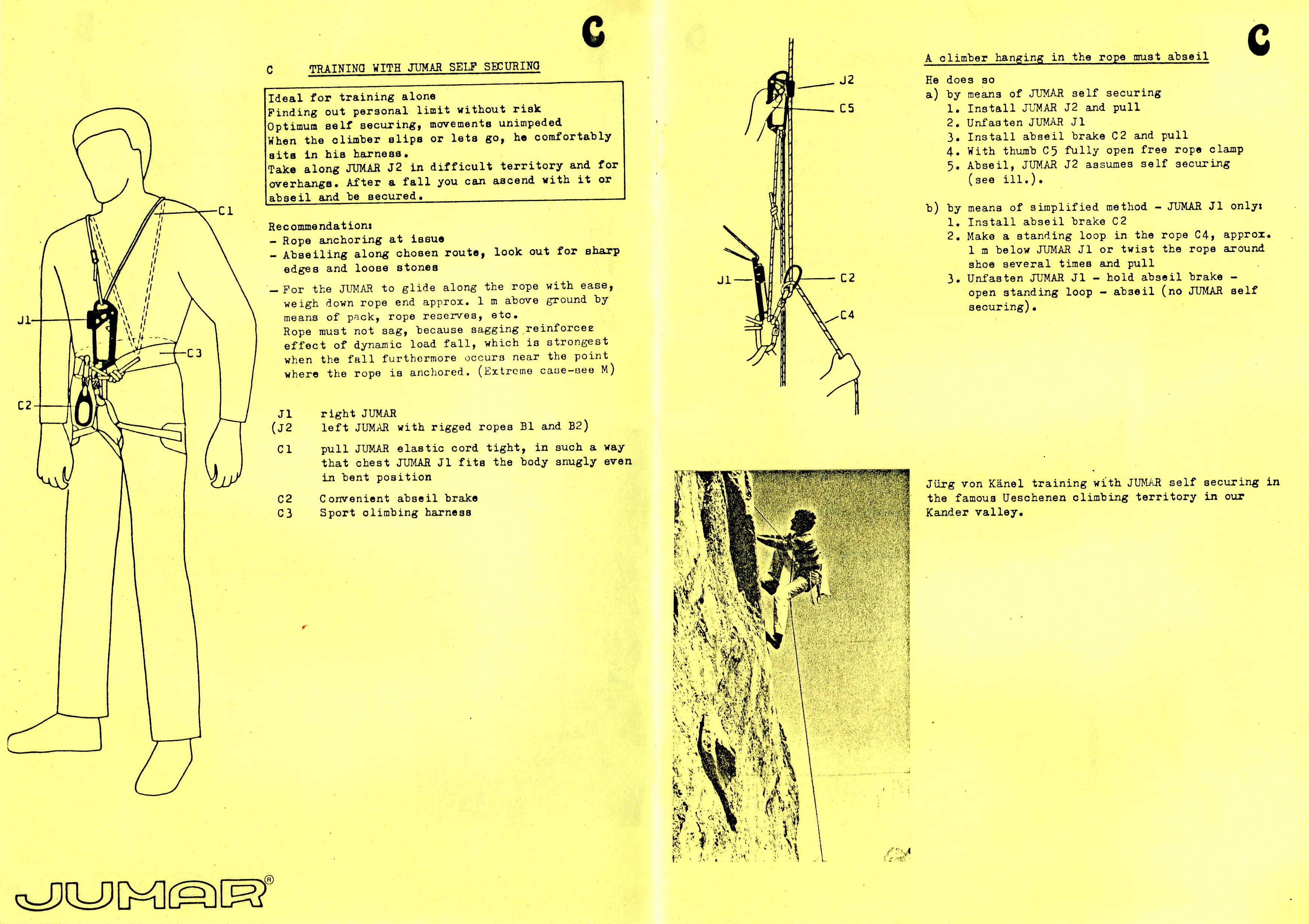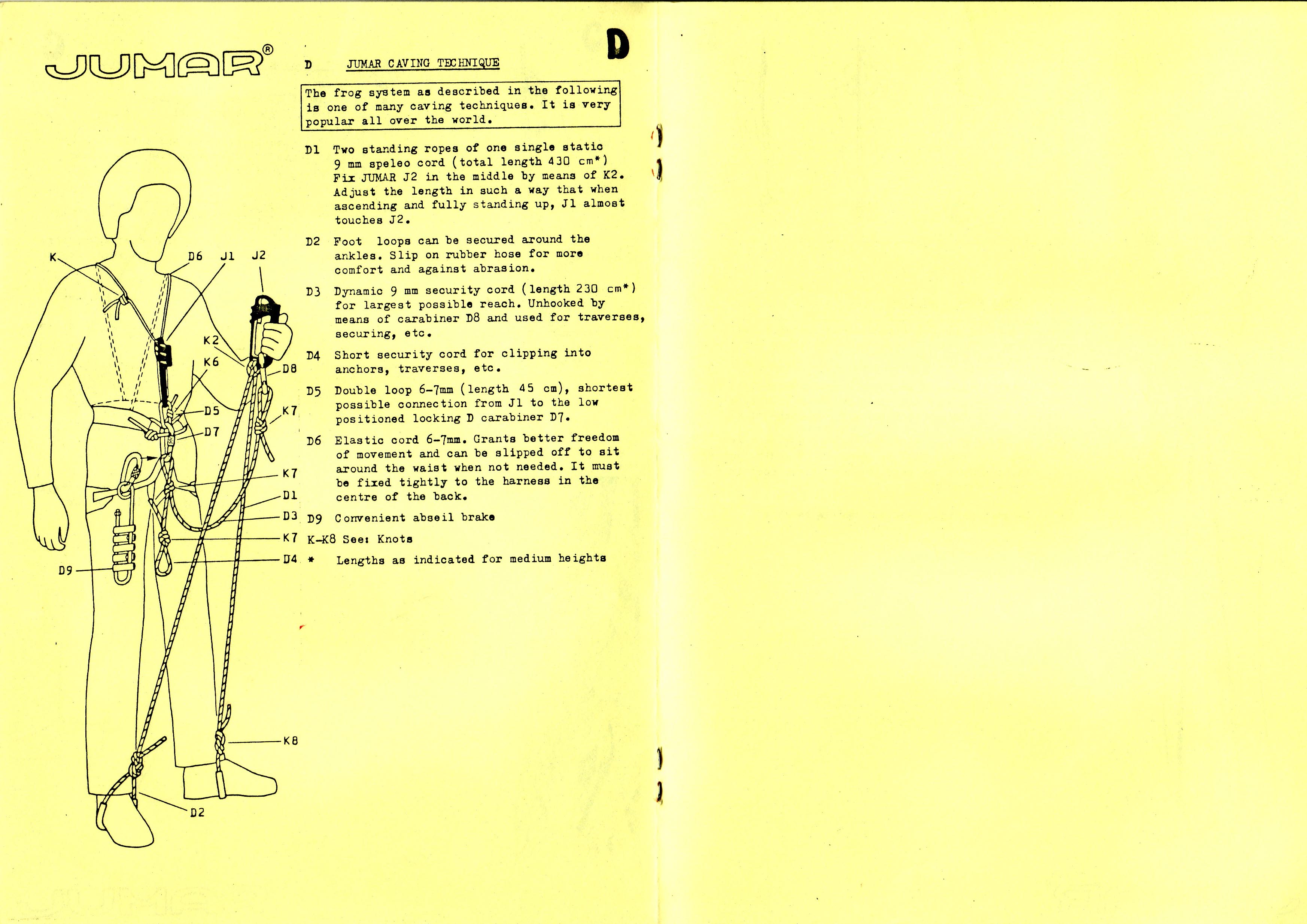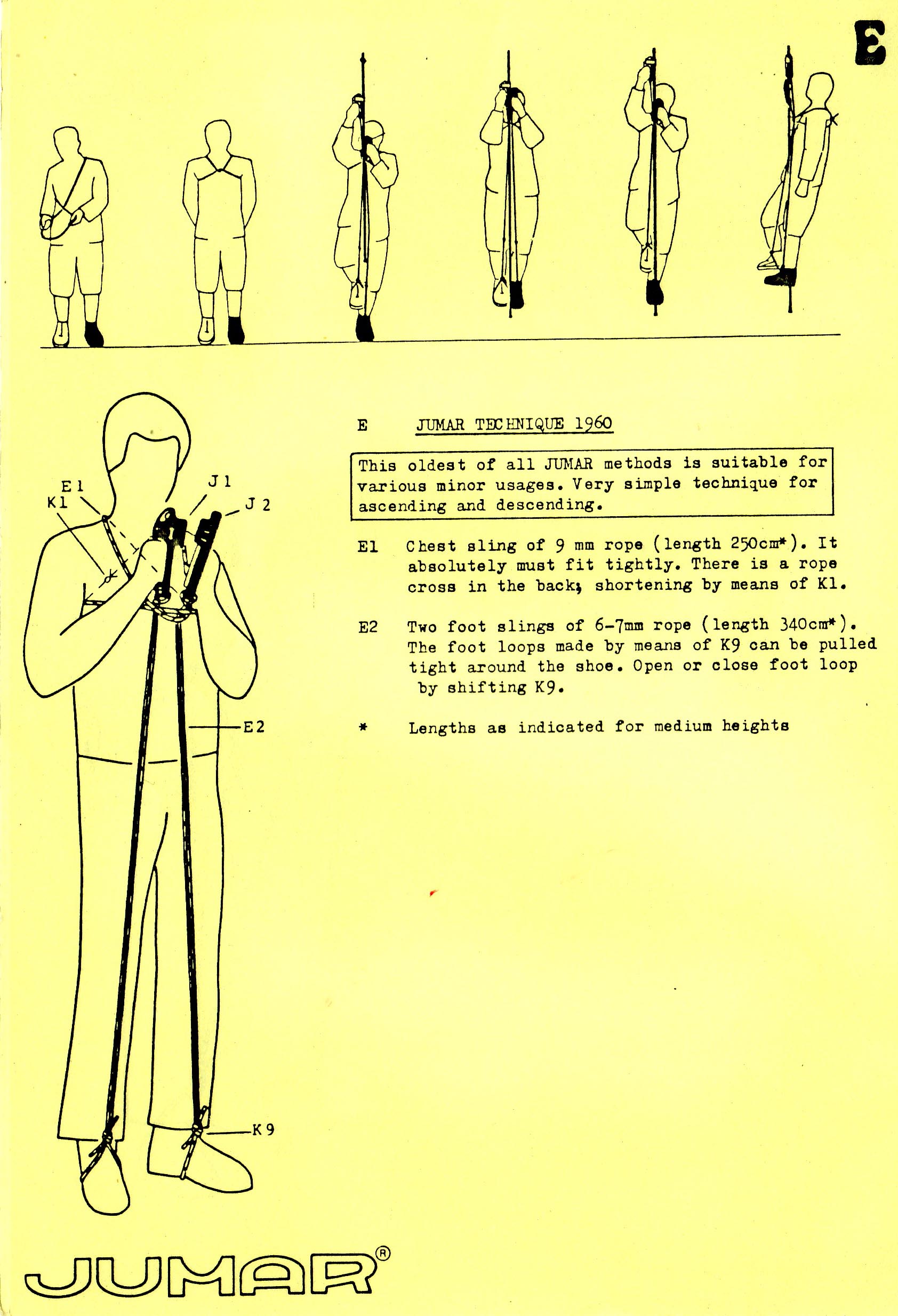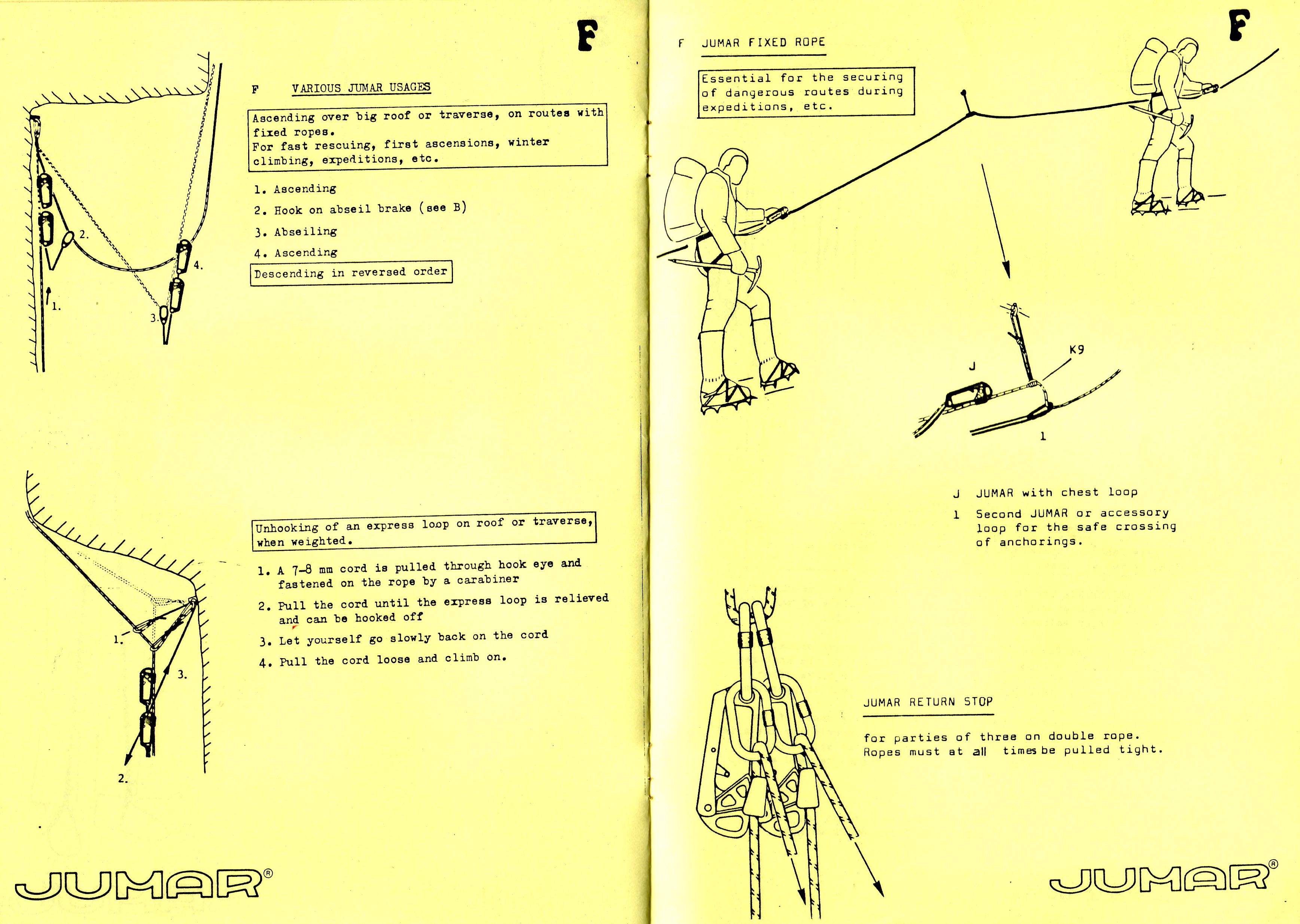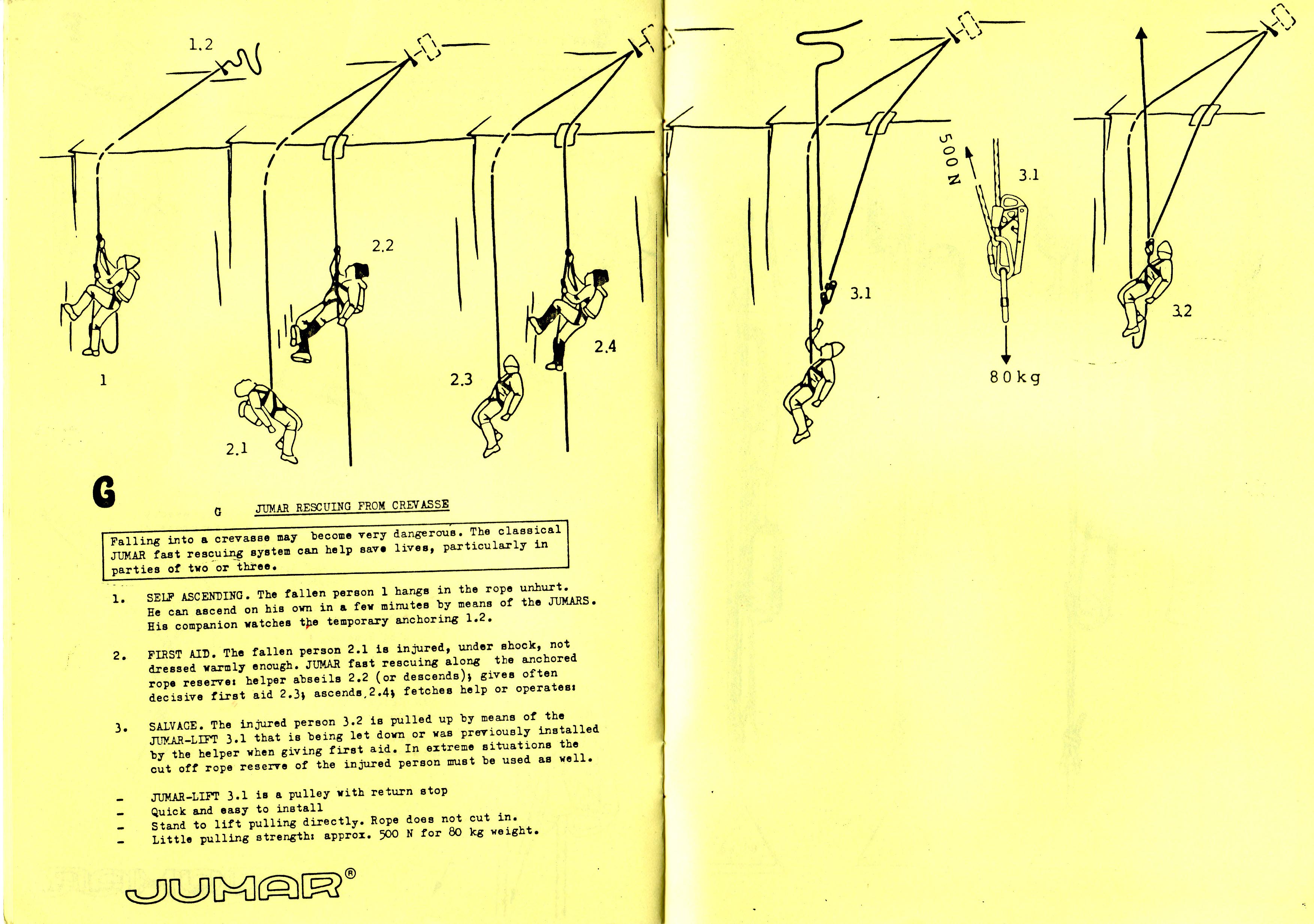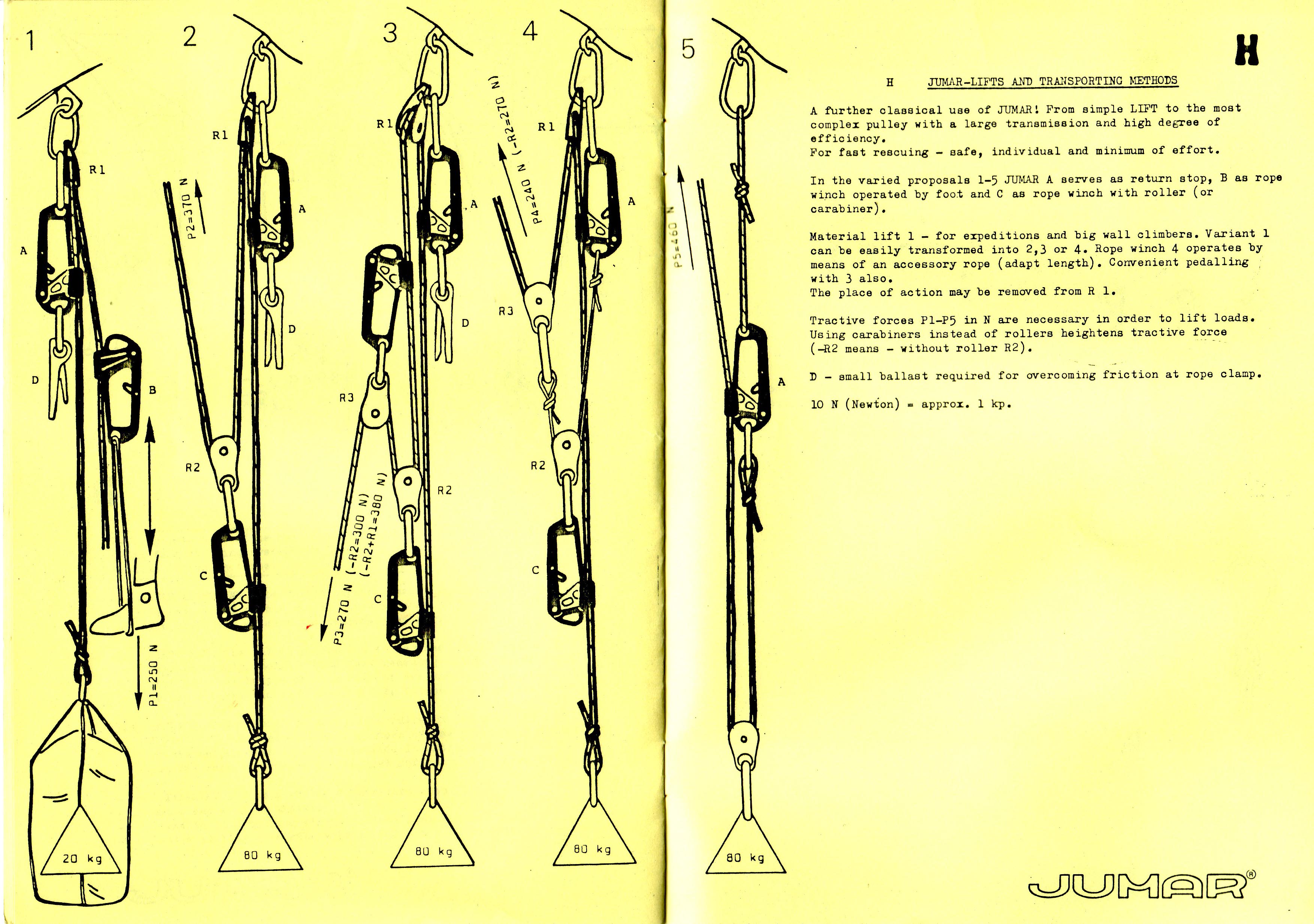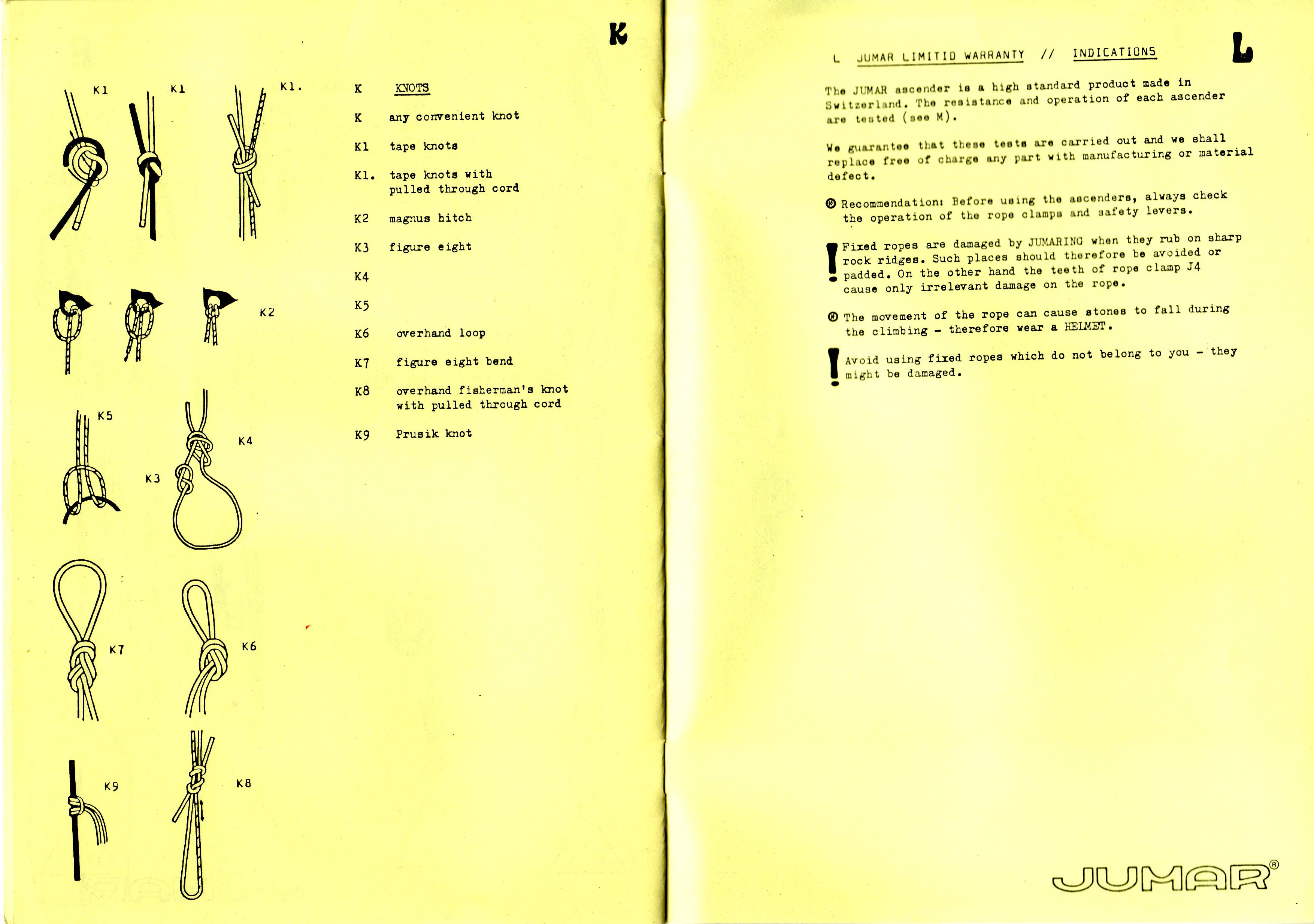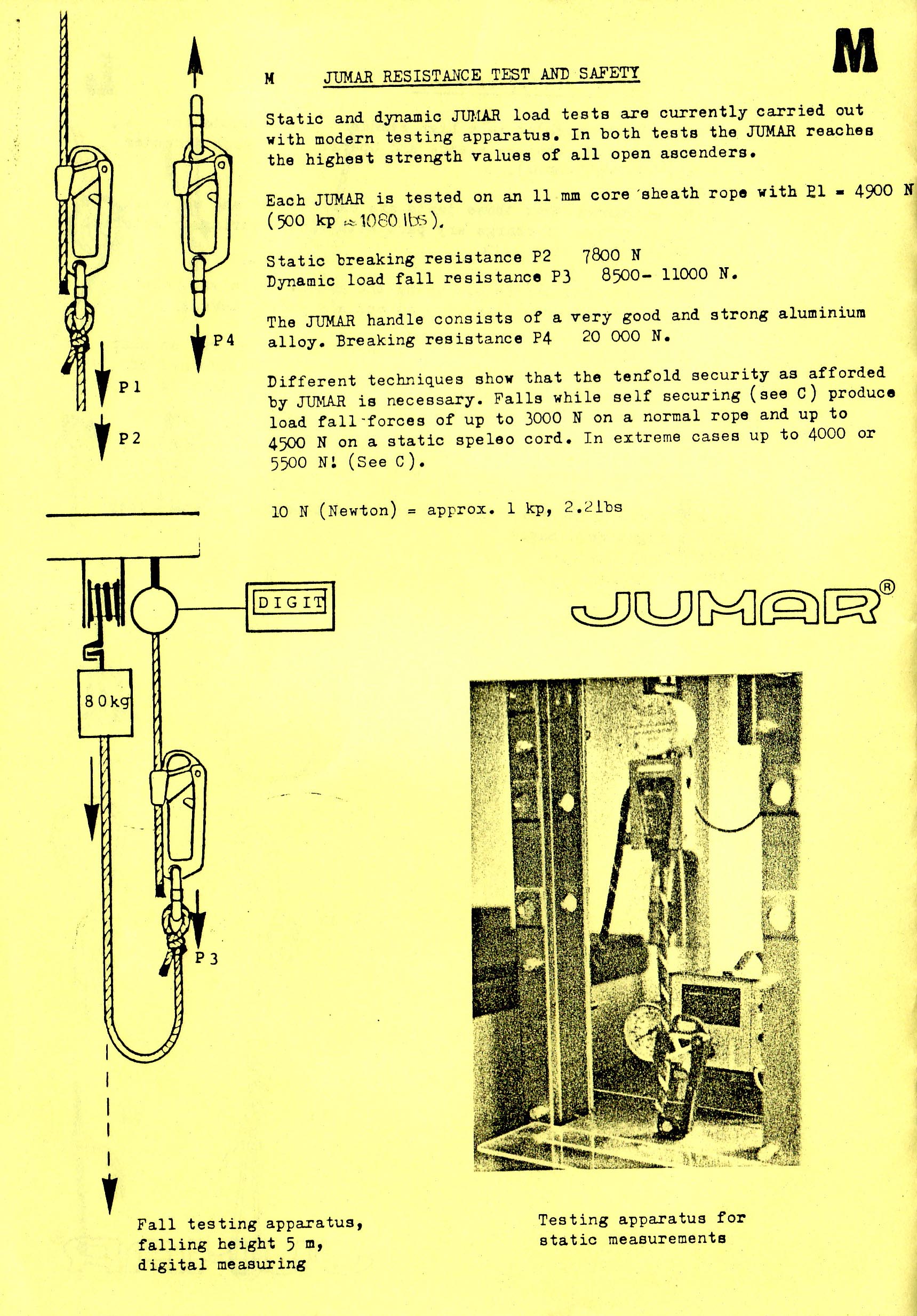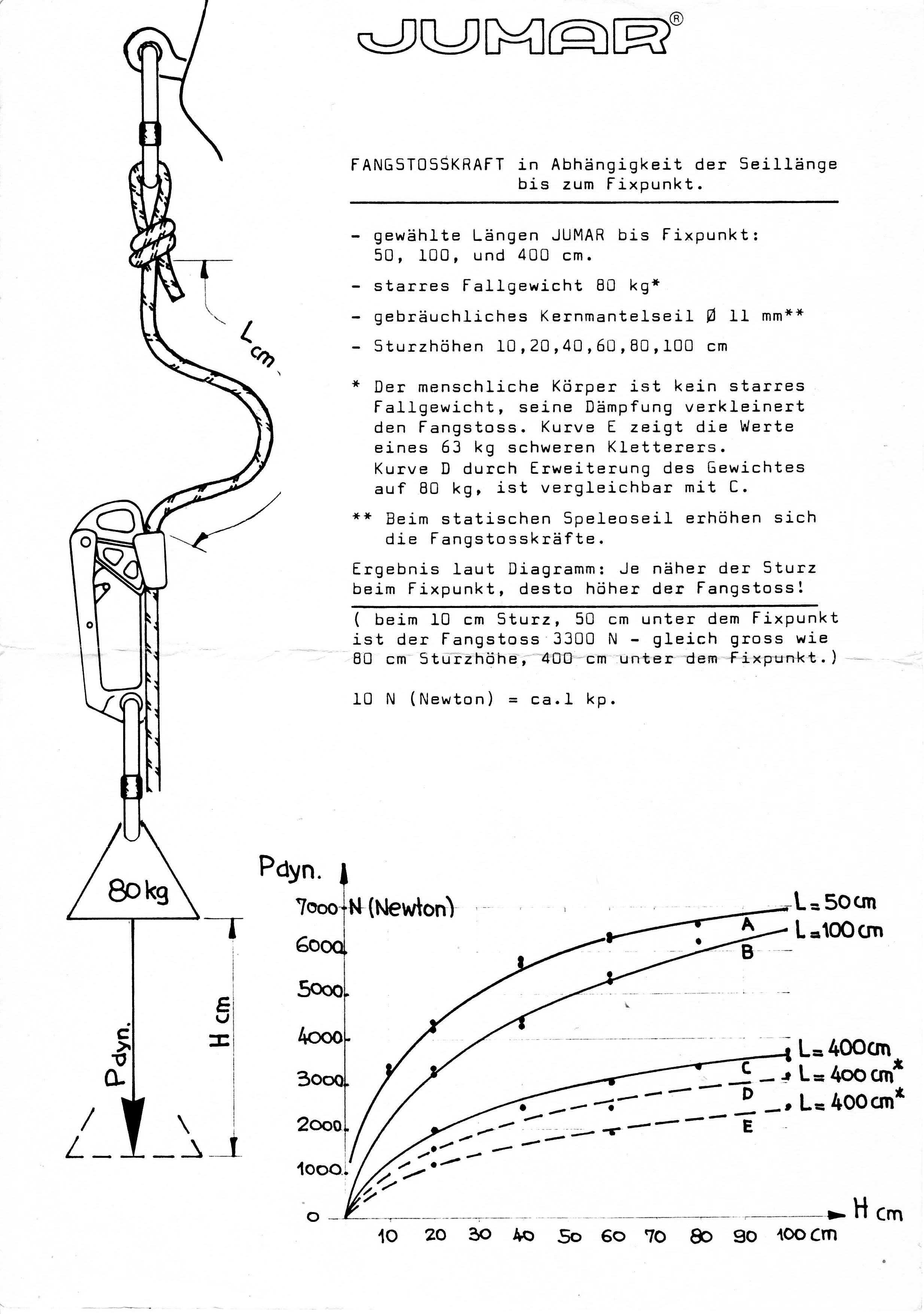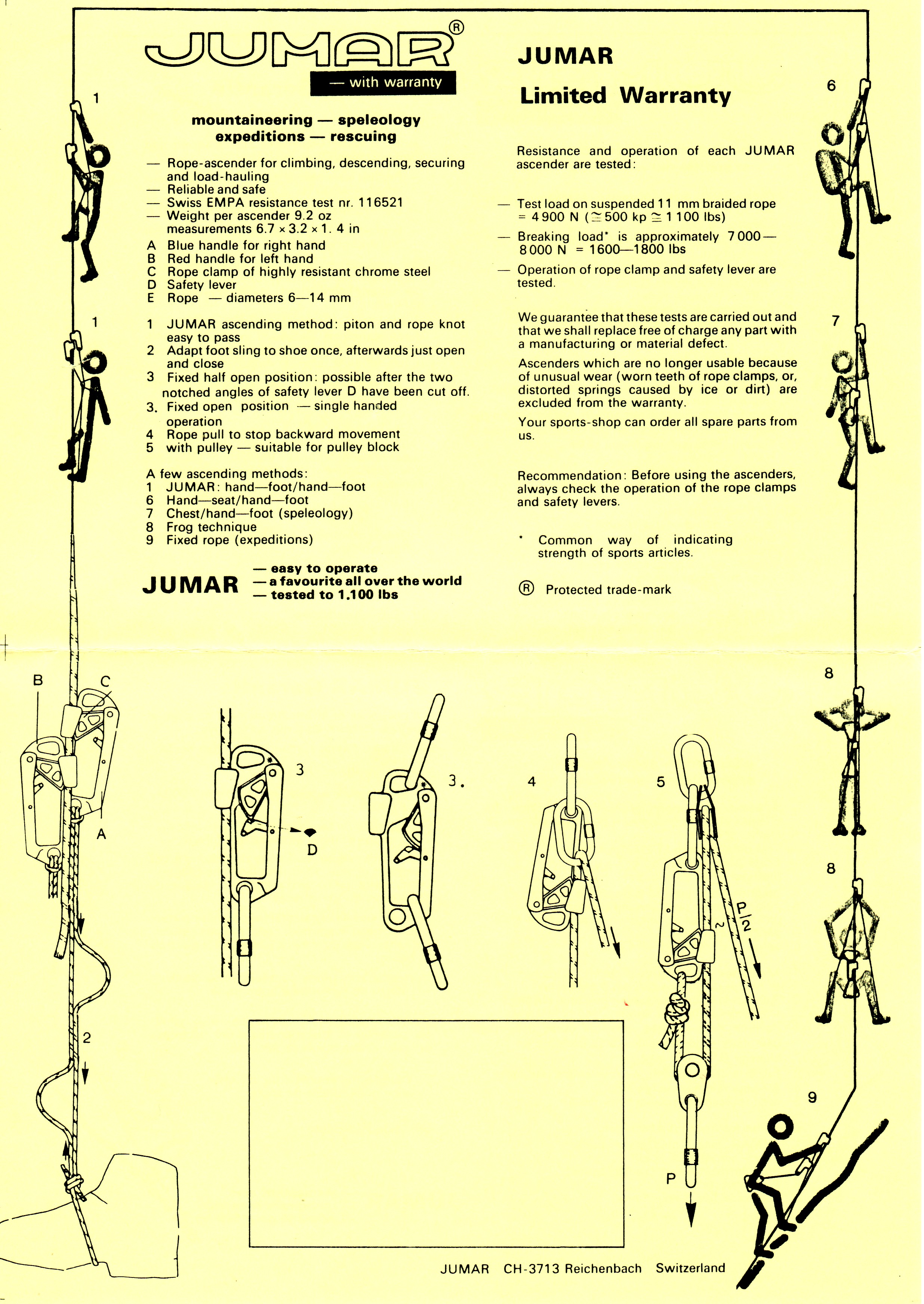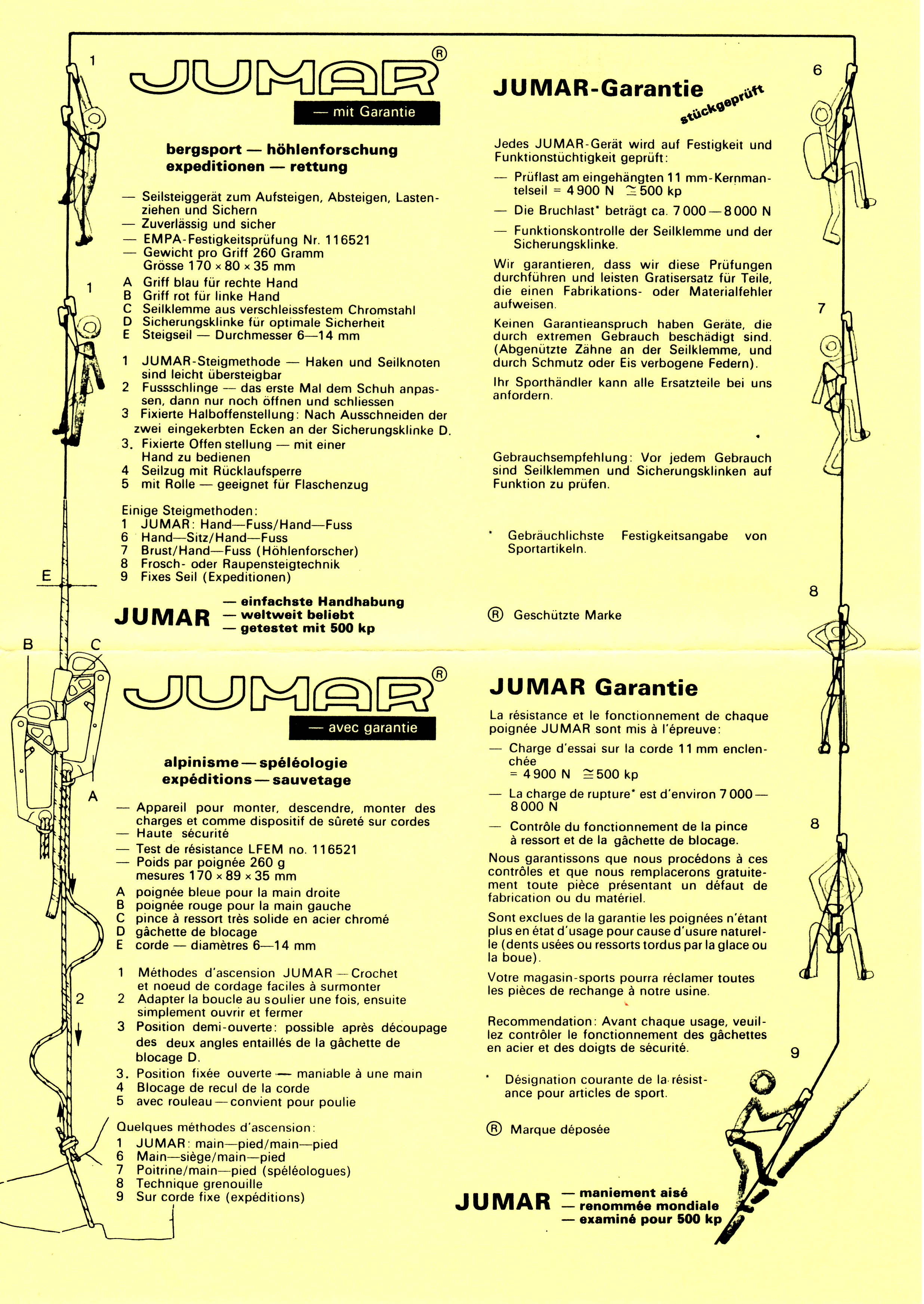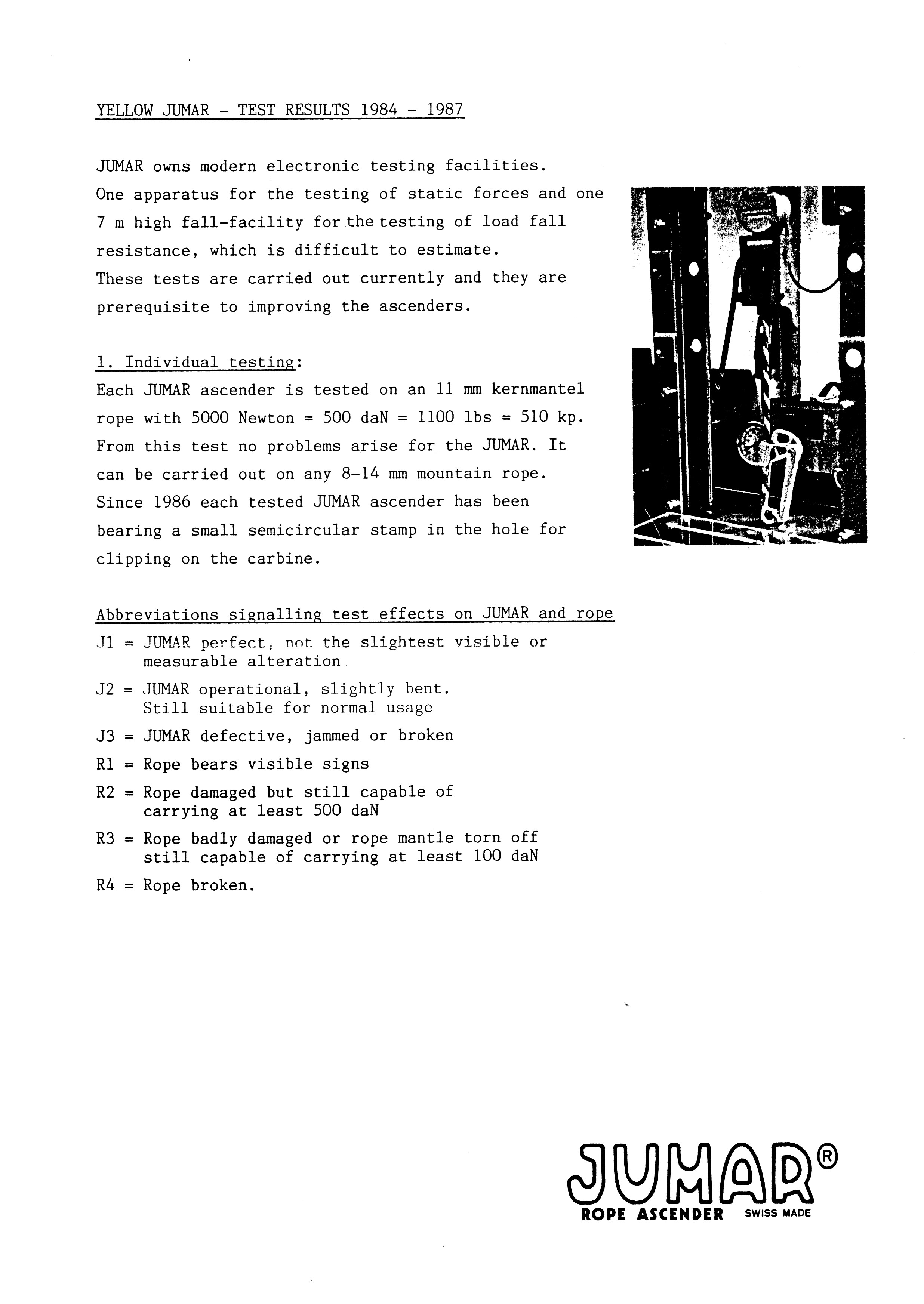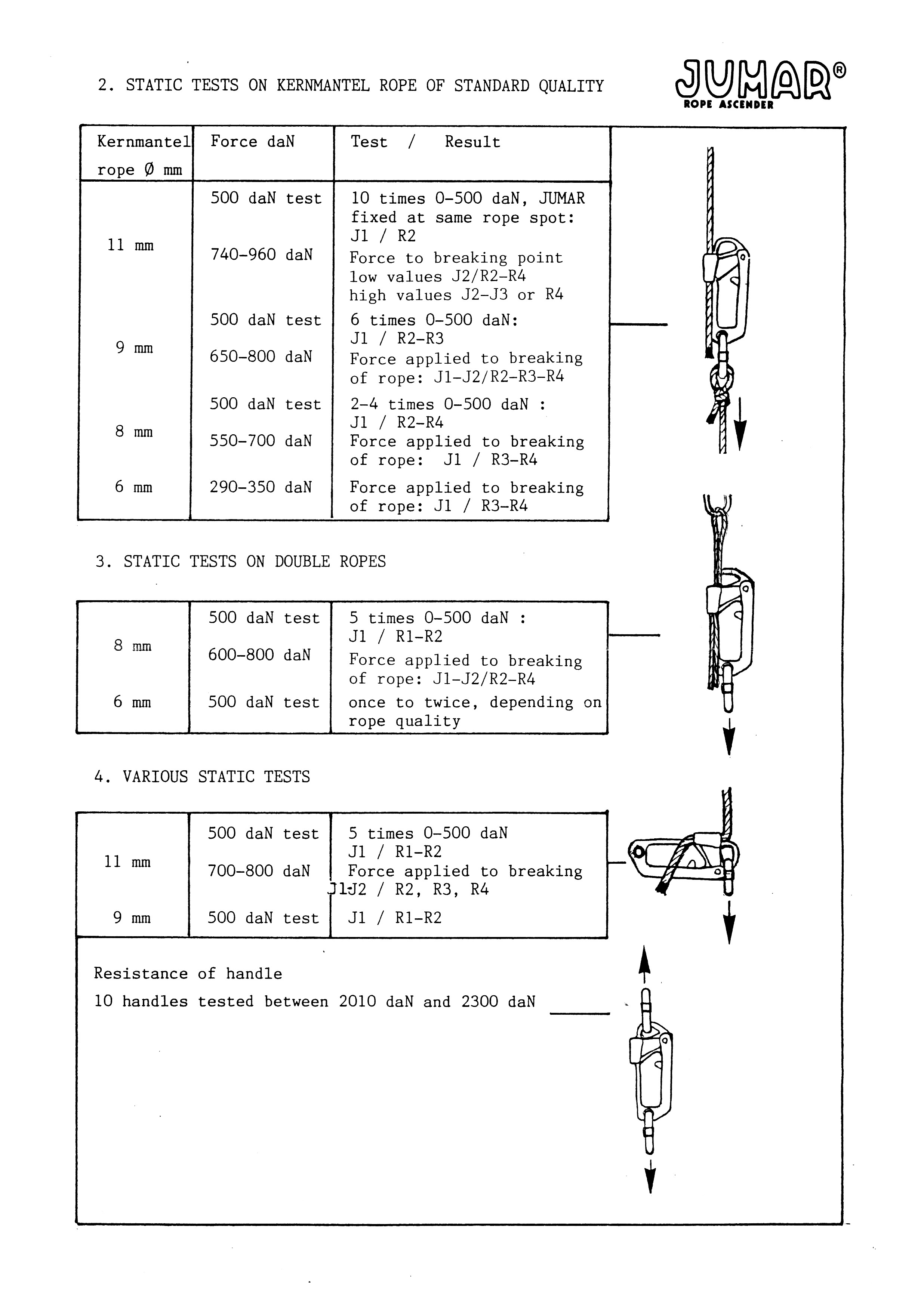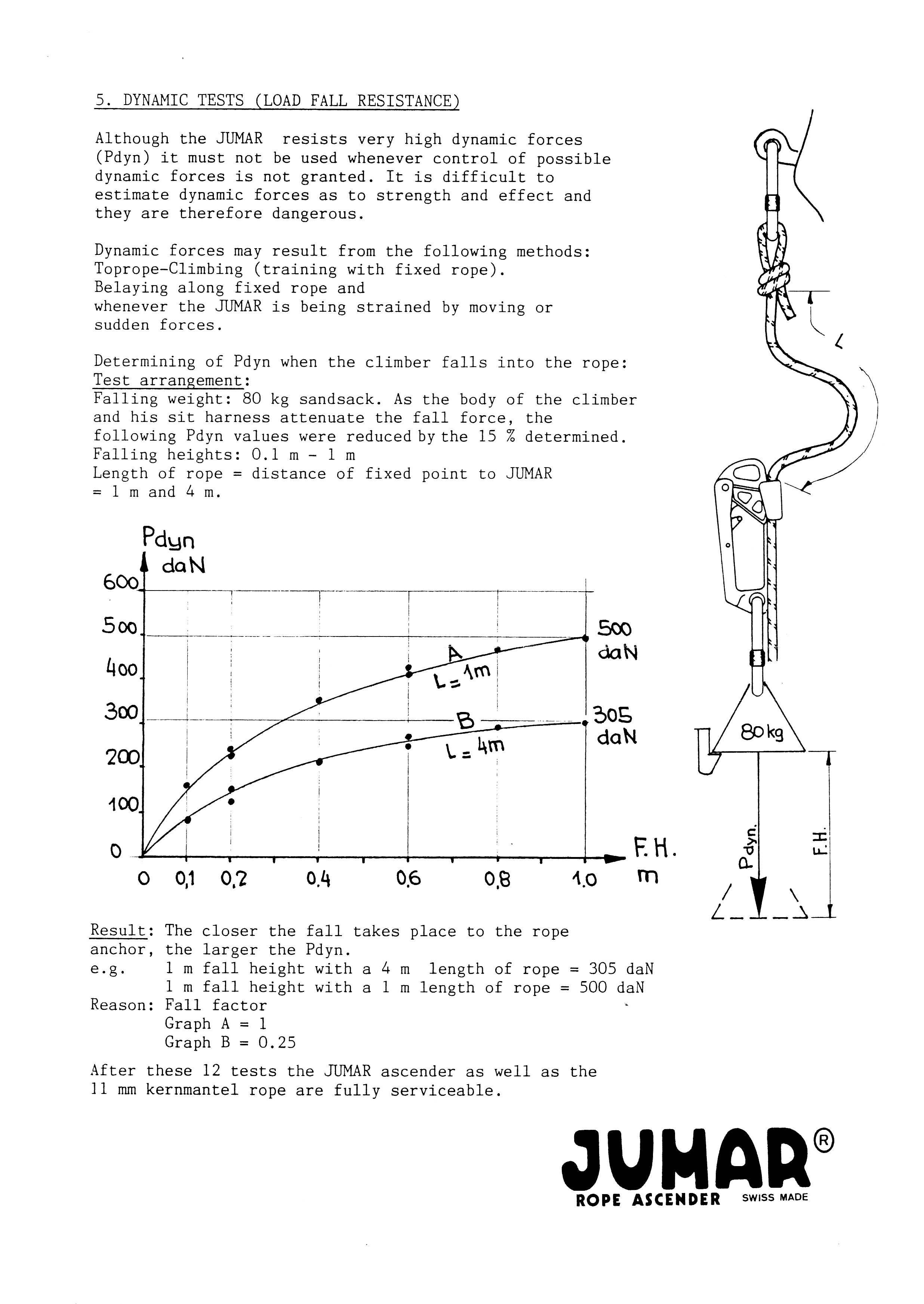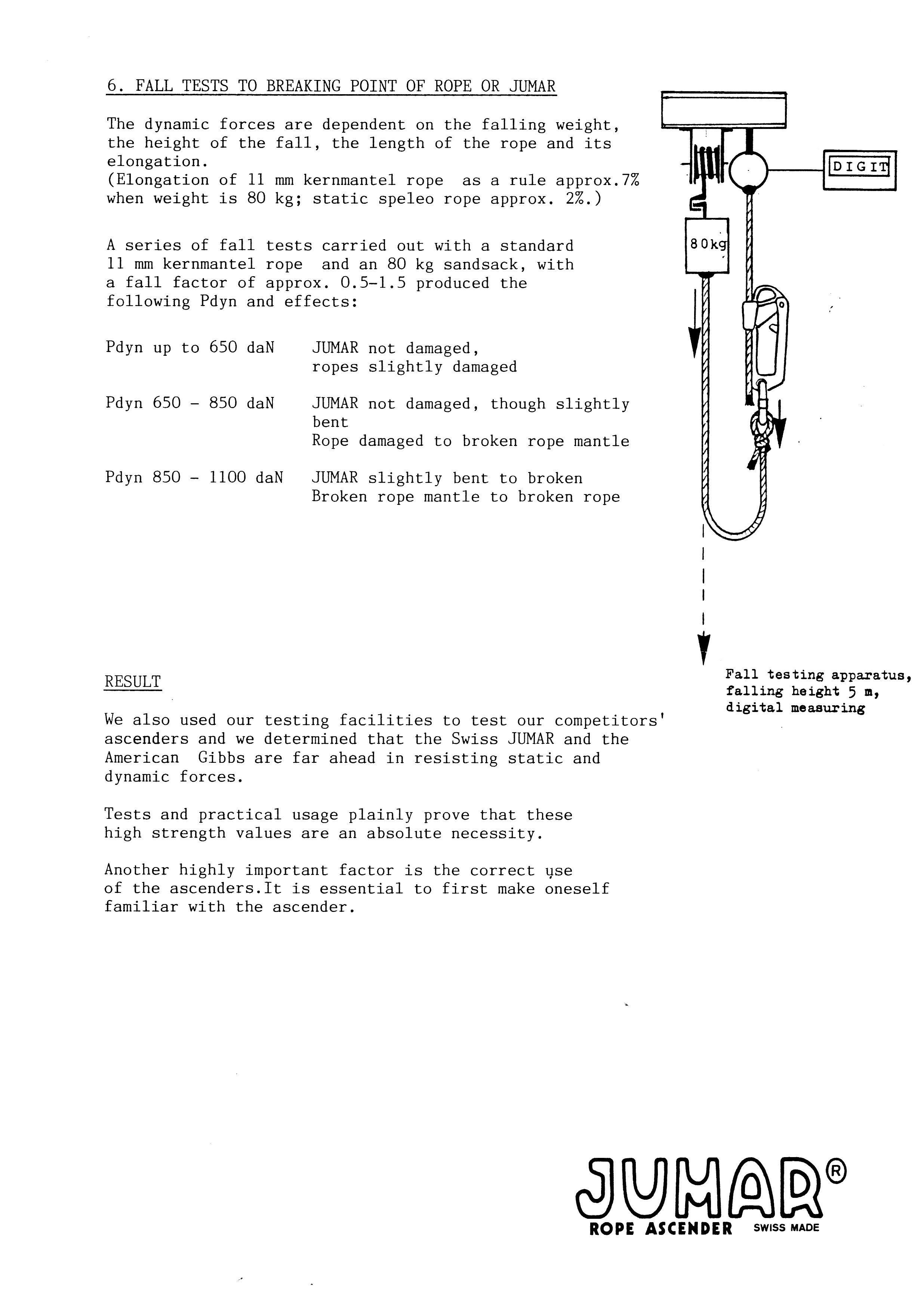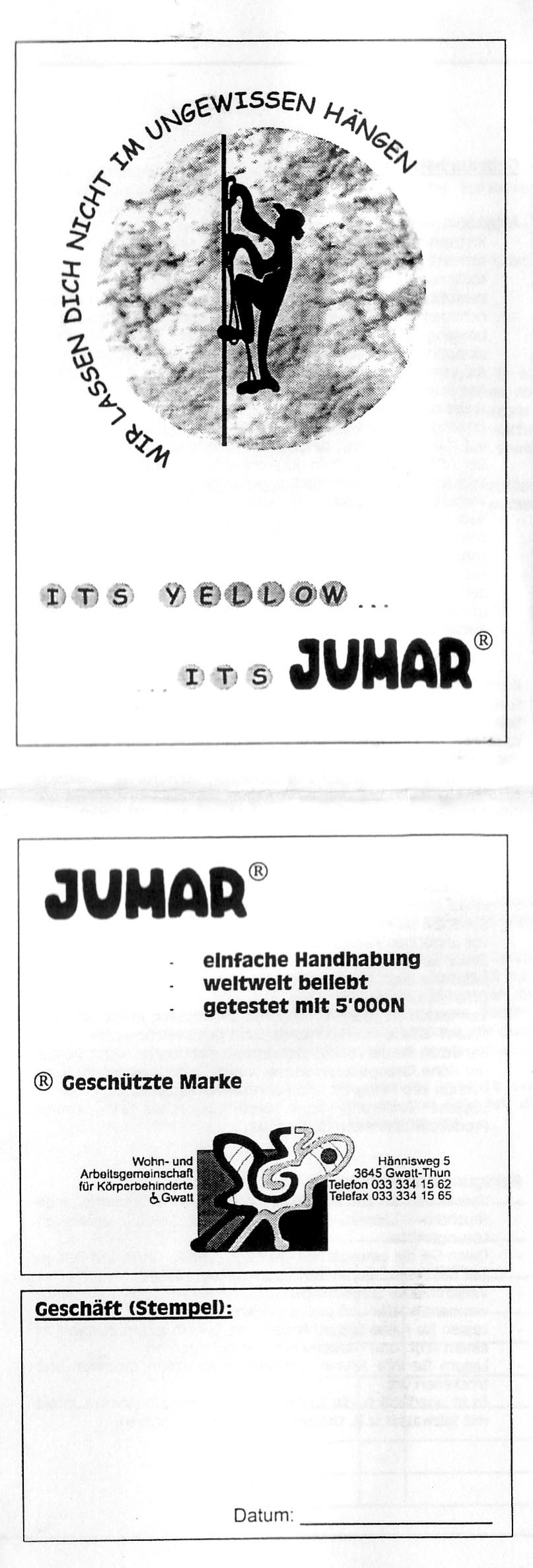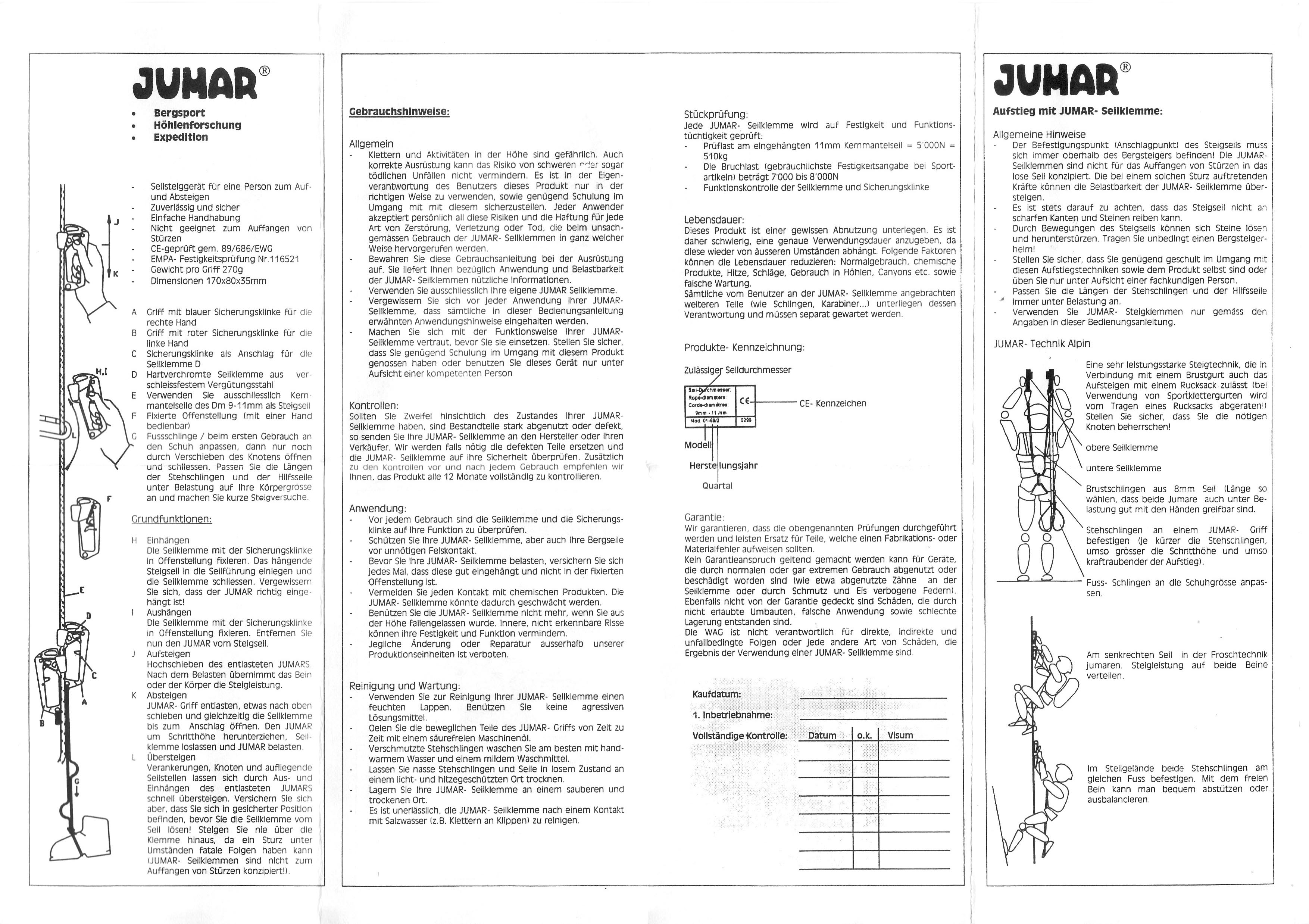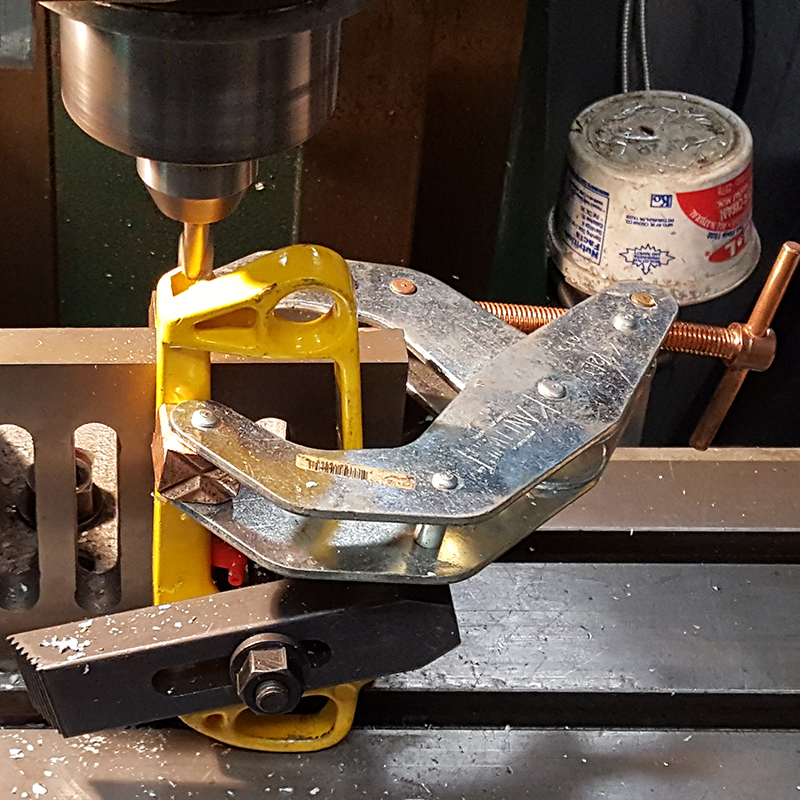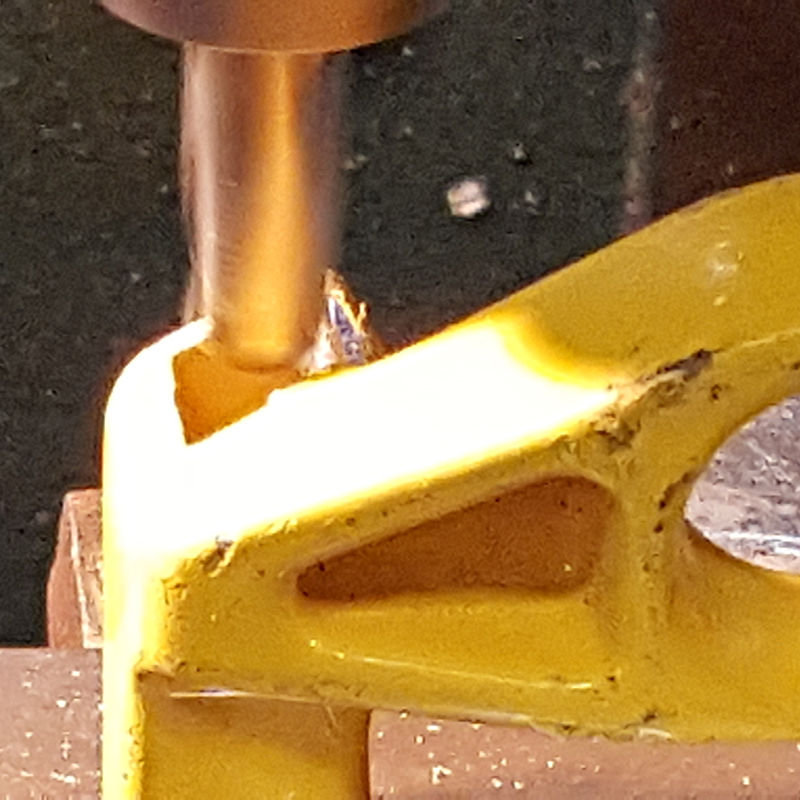Overview
[ Top
| Version B
| Version C
| Version D
| Version E
| WAG
| Fritschi
| Modified
| Return to H.E.C. Ascenders
]
Version A
(#39, 297, 2067)
Technical Details
I acquired one pair of ascenders from Speleoshoppe in 1979, and a second pair from John Friedman on eBay in 2009. I acquired another pair in 2017 as part of Bob Thrun’s collection.
In 1979 the Jumar 79 became available. The most distinctive
difference is the color. The old light gray was replaced by a
new bright yellow. In addition to the color change, numerous other
changes were made to the rest of the ascender.
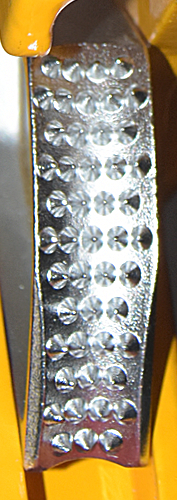 The frame had numerous modifications, but the general Jumar
pattern remains. The most important change is the use of a new,
tougher alloy. This alloy does not appear subject to brittle fracture
like the gray frames were. Most of the frame has been made heavier.
The rope channel is taller, and a third reinforcing rib is cast
into the back of the rope channel and the back of the frame. The
front strap and the strap over the upper attachment hole were
thickened. The lower portion of the ascender was completely redesigned.
The sling attachment hole is a 16 mm. circular hole oriented
horizontally. The frame is 10.3 mm. thick at this point,
giving a very good surface for attaching slings.
The frame had numerous modifications, but the general Jumar
pattern remains. The most important change is the use of a new,
tougher alloy. This alloy does not appear subject to brittle fracture
like the gray frames were. Most of the frame has been made heavier.
The rope channel is taller, and a third reinforcing rib is cast
into the back of the rope channel and the back of the frame. The
front strap and the strap over the upper attachment hole were
thickened. The lower portion of the ascender was completely redesigned.
The sling attachment hole is a 16 mm. circular hole oriented
horizontally. The frame is 10.3 mm. thick at this point,
giving a very good surface for attaching slings.
The cam was also redesigned. A reinforcing bar was added to
the inside of the cam. The cam teeth were enlarged, and the tooth
pattern was changed to (4.5)^3(4.3)^3. The entire cam, including
the teeth, is very well made.
The plastic cam safety is also new. Instead of the old "straight"
design, the new design has a 135° elbow. The safety to pivots
at a similar location as the old safety, so the effectiveness
as a safety is unchanged. The elbow allows half of the safety
to sit inside the handle when not activated, so it does not interfere
as easily with one’s hand. A "beak" on the end of the
cam safety can hold the cam in the half open position if desired.
Similarly, a tab at the elbow can hold the cam 3/4 open (the rope
can slip out here), and the flat between the elbow and pivot provides
a full open hold.
Version A is 179 mm. tall, 77 mm. wide, 36 mm.
thick, and weighs 263 g.
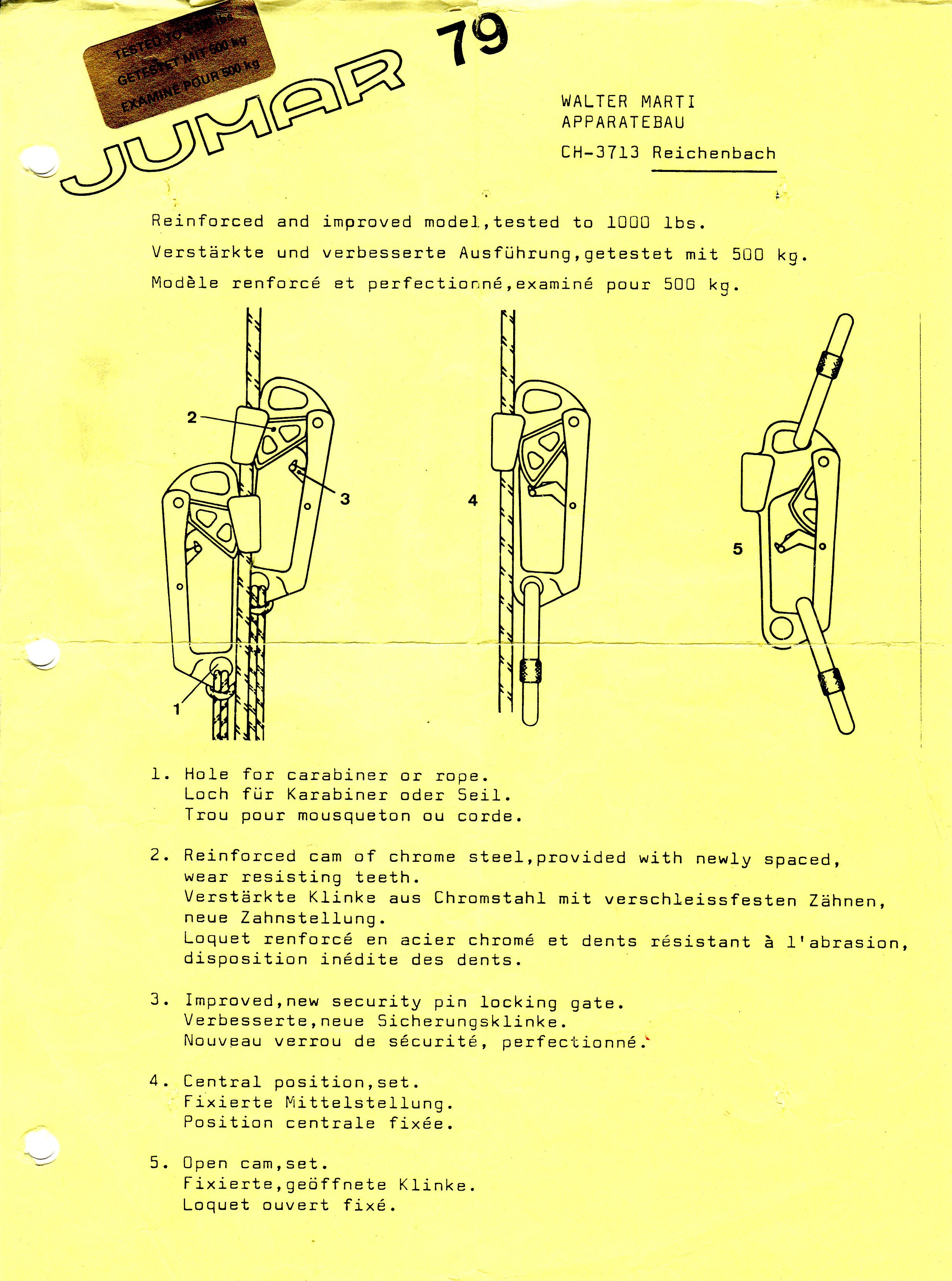 This ascender was developed in response to reports of "gray"
Jumar failures such as the ones mentioned above. The new design
is substantially heavier and more rugged than the older models.
When I visited Walter Marti, he let me pound on a Jumar with a
sledge hammer. I gave it a number of hard blows, blows that were
far worse than one would ever reasonably expect to deliver on
even the hardest caving trip. The Jumar was severely mangled and
distorted after I finished, but it did not crack.
This ascender was developed in response to reports of "gray"
Jumar failures such as the ones mentioned above. The new design
is substantially heavier and more rugged than the older models.
When I visited Walter Marti, he let me pound on a Jumar with a
sledge hammer. I gave it a number of hard blows, blows that were
far worse than one would ever reasonably expect to deliver on
even the hardest caving trip. The Jumar was severely mangled and
distorted after I finished, but it did not crack.
The larger, more widely spaced cam teeth are less sensitive
to mud than the old ones were. The "Gray"
series Jumars had a partially deserved reputation for poor
performance in muddy conditions. The "Yellow" series
Jumars do not seem to have this stigma attached to them. I find
that the "Yellow" Jumars perform better in mud than
the "Gray," but I suspect that the bad reputation of
the old Jumars was partly due to their being compared to knots
rather than other ascenders; after all, one can virtually always
get knots to work.
The elbow in the safety makes the Jumar slightly harder to
use one-handed than the older gray models,
but the difference probably isn't worth worrying about. The same
motion can be used as on the older versions. On the other hand,
the new design is much harder to open accidentally. This is a
persuasive argument in favor of the elbow design. I don't like
the beak on the safety, for the same reasons I don't like the
teeth on the C.M.I. UltrAscender safety.
A penknife solves the problem on this model, the improved safety
on the later Jumars eliminates it completely. A few of the earlier
Jumar 79s had a defective cam safety spring (Montgomery,
N. and D. Mrozkowski, A Note on the Jumar, N.S.S. News, v. 39,
# 1, Jan., 1981, p. 20; Montgomery, N. and D. Mrozkowski,
The New Jumar, Caving International Magazine, #10, Jan., 1981,
pp. 42-46). One end of the spring was too short, so the
spring tended to pull through and unwind, losing its ability to
function in the process. These were replaced under warranty by
a newer, 1.5 mm. longer spring which cured the problem.
When the Jumar 79 came out, I bought a pair. Version B
came out very shortly thereafter, and I bought a second pair.
I took three of the ascenders and a Gossett
Box and made a climbing system based on the Cuddington 3-phase.
Since then I have done virtually all of my vertical work with
this system, or the Texas System obtained by leaving one Jumar
and the box in the truck. Because Jumars were my normal caving
ascender for many years, I have more experience with them than with almost any other
devices in my collection. I have been happy with their performance
under a wide range of caving conditions, including clean ropes,
dust, mud, snow, ice, and waterfalls. I've used them on ropes
ranging from 7 mm. to 13.5 mm. including Goldline, Samson,
BlueWater II and III, PMI of various flavors, Mammut, Edelrid,
and even an oil soaked piece of manila hanging from an 1898 vintage
oil derrick. In every case, they have worked, although climbing
an iced Edelrid rope took a bit of special effort. In the 1990s,
I retired the Version A ascenders, but I haven't given up
on Jumars - I'm using Version E now. The Jumar 79 series
ascenders remain my favorite for many applications. Many other
ascenders are smaller and lighter, but in many cases I'll sacrifice
space and weight in favor of versatility and ease of use. The
Jumar is strong, well made, reliable, comfortable, easy to use,
easy on ropes, versatile, rugged, fast, and just plain feels right.
Other ascenders have many of these properties, but the Jumar puts
them together in a package that I am very happy with.
[ Top
| Version A
| Version C
| Version D
| Version E
| WAG
| Fritschi
| Modified
| Return to H.E.C. Ascenders
]
Version B
(#40, 3459)
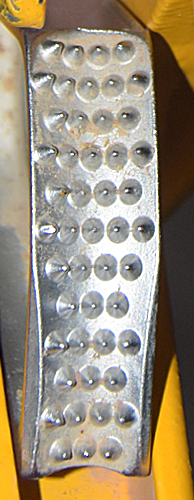 Technical Details
Technical Details
I acquired this pair of ascenders from Speleoshoppe in 1979. On Rope 1 donated a left-handed one in 2021.
The cam safety was modified in late 1979. The new design moved
the beak from the tip of the safety to the elbow. The beak is
shielded by two breakaway tabs. If the tabs are not removed, the
beak is nonfunctional and the only cam hold open position is full
open. If the breakaway tabs are removed, the beak is exposed and
can be used to hold the cam half open. The full hold open feature
remains functional.
Version B is 179 mm. tall, 78 mm. wide, 37 mm.
thick, and weighs 273 g.
This change eliminates my one complaint with the original Version A.
Naturally, I leave the tabs in place.
[ Top
| Version A
| Version B
| Version D
| Version E
| WAG
| Fritschi
| Modified
| Return to H.E.C. Ascenders
]
Version C
(#41)
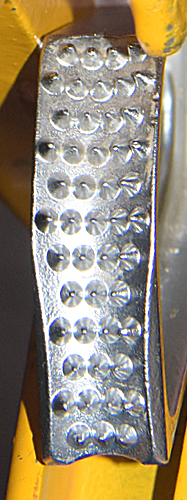 Technical Details
Technical Details
I received this left-handed ascender as a gift during my
visit with Walter Marti in 1982.
Version C is 179 mm. tall, 78 mm. wide, 37 mm.
thick, and weighs 271 g. It is identical to Version B
except two holes have been drilled near the top and bottom of
the rope channel, and a 4 mm. stainless steel is press fit
into each hole. The pins are partially exposed on the inside of
the rope channel.
This ascender was a prototype developed for use on an Austrian
caving expedition. The Austrians used it and returned it to to
Walter, who passed it on to me.
The pins are added as wear resistors. Europeans usually use
the Frog System for caving, and the chest ascender in the Frog
tends to wear rapidly since it is moved up the rope while the
caver’s weight is pulling the ascender rope channel back against
the rope. This causes far more ascender wear than most U.S. climbing
systems. After 10 years of use, during which I wore out a dozen
brake bars on my racks
and several figure 8s,
I did not even finish wearing through the paint on the inside
of the rope channel of my Version A Jumars. The reason is
twofold: using clean ropes whenever possible, and an ascending
system where ascenders are not raised while they are loaded.
The steel pins will have to wear away before the aluminum rope
channel can wear significantly. These pins are an excellent example
of a very simple design modification which has no real disadvantages
and significantly improves the overall ascender.
|
 |
My Version C is a right-handed ascender. If you have
a left-handed Version C (with a (4.5)^3(4.3)^3 tooth-pattern
cam) that you are willing to part with, please
email me. |
|
[ Top
| Version A
| Version B
| Version C
| Version E
| WAG
| Fritschi
| Modified
| Return to H.E.C. Ascenders
]
Version D
(#265, 270, 285, 1532, 3668)
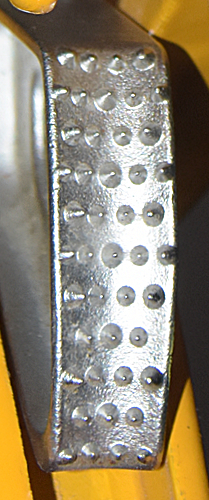 Technical Details
Technical Details
I acquired my Jumar 79, Version Ds used on eBay in 2009 as follows: a left from J. Matzke in 2009, a pair from Charles Denning in 2009, another left from Henderson L. Holman IV in 2009, a pair from Jeff DeFreest in 2010, and a pair from eBay seller tlc_company/2handgoods in 2025.
Version D is 179 mm. tall, 78 mm. wide, 37 mm.
thick, and weighs 272 g.
The frame on Version D is identical to the Version B frame,
but the cam is different. The Version D cam has one less row of
teeth, giving a (4.5)^3(4.3)^2(4) tooth pattern. The separation
between the rows of teeth is essentially unchanged, but the cam
face is shorter. The Version D cam toe is slightly more rounded
than the Version B cam toe. The teeth on the Version D cam
are slightly smaller than the teeth on the Version B cam.
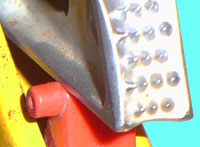 |
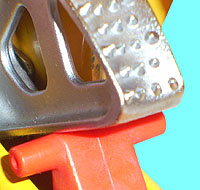 |
| Version C Cam |
Version D Cam |
The final row of teeth on the Version B ascender never come
into play, so removing them did not harm. I suspect that removing
another row or two would not have hurt either. I notice no difference in the performance of the Version B and D
cams.
One reason that I have so many of these is that I use these regularly in some of my favorite climbing systems, although I prefer the versions with the wear pins, for the obvious reason.
[ Top
| Version A
| Version B
| Version C
| Version D
| WAG
| Fritschi
| Modified
| Return to H.E.C. Ascenders
]
Version E
(#273, 1908)
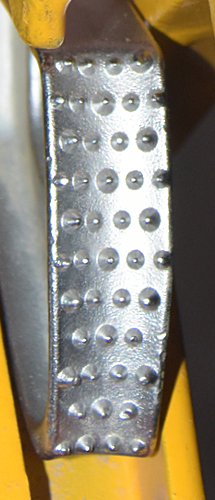 Technical Details
Technical Details
I acquired this pair of ascenders directly from Walter Marti
(inventor and manufacturer of the Jumar) in March 1989. They were
given to me as a gift so that I could evaluate them for the article
I published in The Nylon Highway #29. I acquired a second pair on eBay from Caleb Laurence at Laptop Specialties in 2012.
Version E is 179 mm. tall, 78 mm. wide, 37 mm.
thick, and weighs 274 g. It is identical to Version D
except two holes have been drilled near the top and bottom of
the rope channel, and a 4 mm. stainless steel is press fit
into each hole. The pins are partially exposed on the inside of
the rope channel.
Version E differs from Version B in two ways: it incorporates
the new cam introduced in Version D and the wear pins introduced
in Version C.
[ Top
| Version A
| Version B
| Version C
| Version D
| Fritschi
| Modified
| Return to H.E.C. Ascenders
]
WAG Jumar
(#273, 2176)
Technical Details
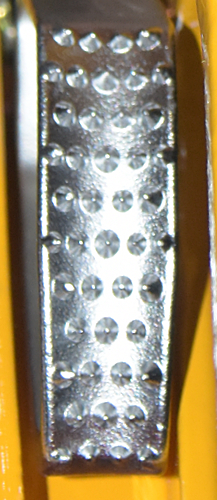 I acquired this pair of ascenders from International Military Sales in 2009. I acquired another pair in 2017 as part of Bob Thrun’s collection.
I acquired this pair of ascenders from International Military Sales in 2009. I acquired another pair in 2017 as part of Bob Thrun’s collection.
These Jumars are 178 mm. tall, 78 mm. wide, 36 mm.
thick, and weigh 278 g. each. The only difference between this pair and Version D is that the cam rivet on these has a solid head in the rear rather than a rolled head.
The front of the frame is stamped with a "0" above the cam rivet.
I bought these new in 2009, thinking that they must be Fritschi Jumars, but apparently they are not. The stickers behind the cam suggest that mine were made in 2002 and 2003. The instructions identify the manufacturer as Wohn und Arbeitsgemeinschaft für Körperbehinderte Gwatt of Gwatt, Thun.
|
 |
If you know the full history of Jumar manufacture after Walter Marti, please email me. |
|
[ Top
| Version A
| Version B
| Version C
| Version D
| WAG
| Modified
| Return to H.E.C. Ascenders
]
Fritschi Jumar
(#271, 2175, 2178)
Technical Details
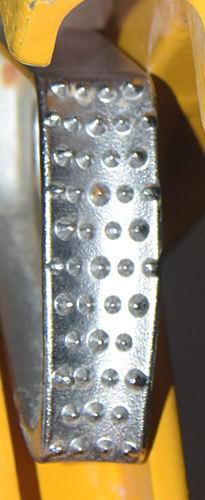 I acquired my Fritschi Jumar ascenders new on eBay from Michel Brinkman in 2009. I acquired two more pairs in 2017 as part of Bob Thrun’s collection.
I acquired my Fritschi Jumar ascenders new on eBay from Michel Brinkman in 2009. I acquired two more pairs in 2017 as part of Bob Thrun’s collection.
The Fritschi Jumar is 179 mm. tall, 78 mm. wide, 36 mm.
thick, and weighs 272 g. It is identical to Version D, but made by Fritschi.
The front of the frame is stamped with an "A" above the cam rivet.
Fritschi has discontinued making this design Jumar, although rumors were that they would be coming out with a new model. I could not resist getting the last of the yellow breed.
[ Top
| Version A
| Version B
| Version C
| Version D
| Version E
| WAG
| Fritschi
| Return to H.E.C. Ascenders
]
Modified Version D
(#1905)
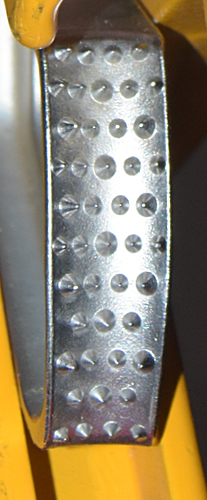 Technical Details
Technical Details
I acquired this pair of Version D ascenders from Charlotte Phillips in 2012 and modified them in 2017.
The modification enlarged the basal hole.
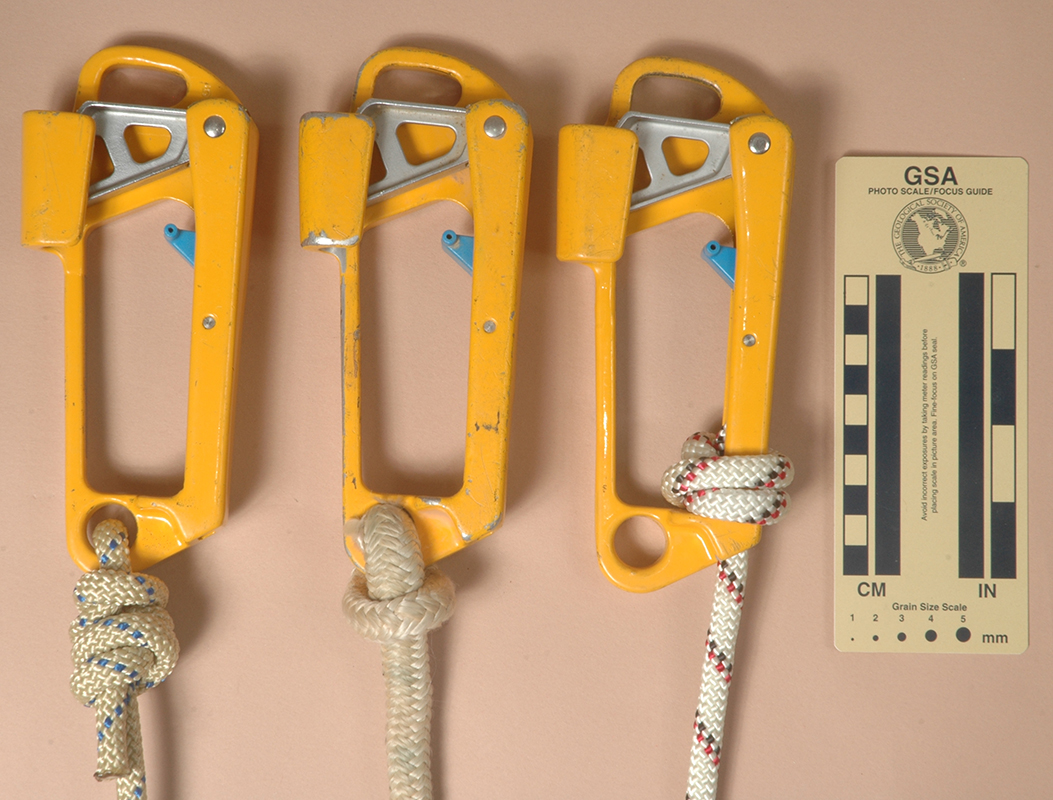 My motivation for modifying these Jumars was to improve the efficiency of my Mitchell rig by lowering the top ascender. Consider the three Jumars in the photo:
My motivation for modifying these Jumars was to improve the efficiency of my Mitchell rig by lowering the top ascender. Consider the three Jumars in the photo:
- Most people would tie into the ascender eye with a knot, such as in the left-hand ascender,
but this means that the upper ascender will be 50 mm. or more above the box.
- For many years, I used a splice in Samson 2-in-1 rope to lower the ascender as shown on the middle ascender.
This lowered the ascender about 30 mm., but still left it 20 mm. higher than ideal.
- Enlarging the basal hole in the ascender allows me to rig the Jumar as shown on the right. This is the way that I used to rig the old
gray Jumars.
Modifying the Jumar allows me to rig it without any knot or splice below the Jumar, lowering the ascender by 50 mm. While climbing, this reduces the height that I have to raise my right arm by 50 cm. for the entire duration of the climb.
Don't worry about the tie-in point being on the back of the handle - because of the sloped base on the Jumar, the entry point on the back is actually about 7 mm. closer to the grip point on the main line than the base of the eye - effectively gaining another 7 mm., making the net gain almost 60 mm.
There are two ways to enlarge the basal hole: by hand or by machine:
- The original opening is tapered and amount of material to be removed is rather small, so careful work with a file is feasible.
- I used a vertical milling machine and a ball end mill as shown in the following photos.
|
 |
Warning:
Do not even consider using a twist drill in a drill press or a hand drill -
you will almost certainly ruin your ascender. |
 |
|
[ Top
| Version A
| Version B
| Version C
| Version D
| Version E
| WAG
| Fritschi
| Modified
]




